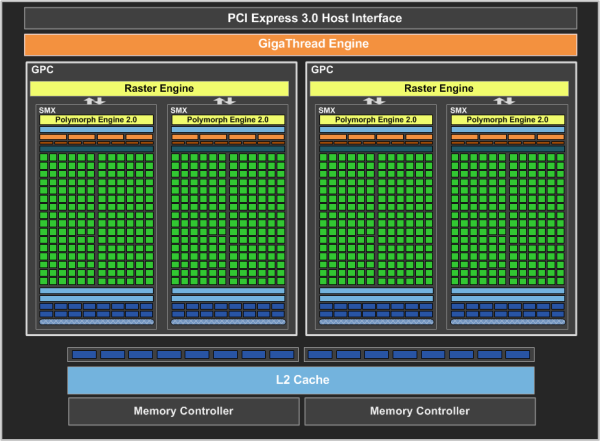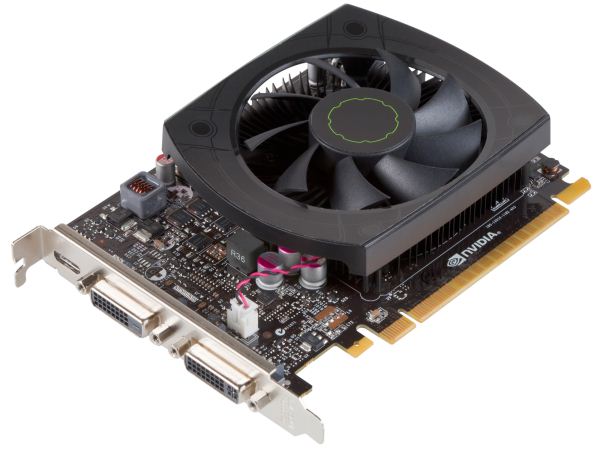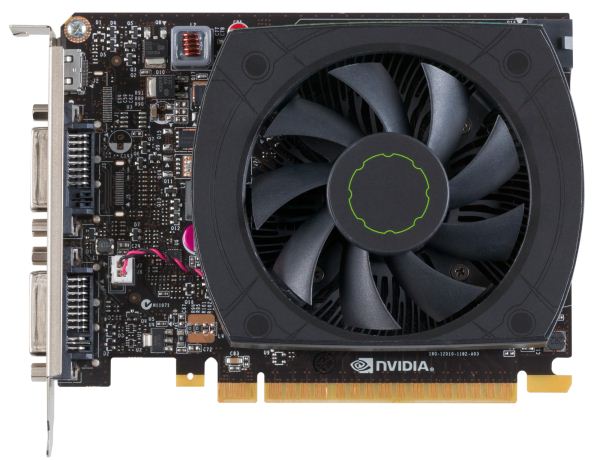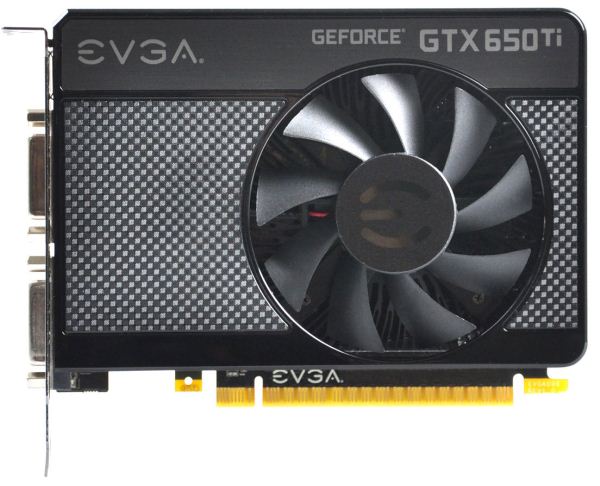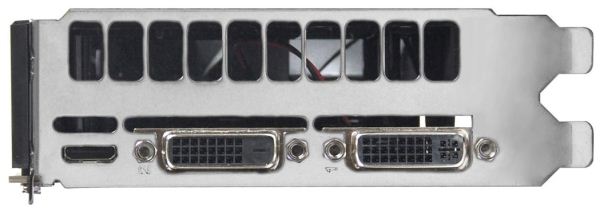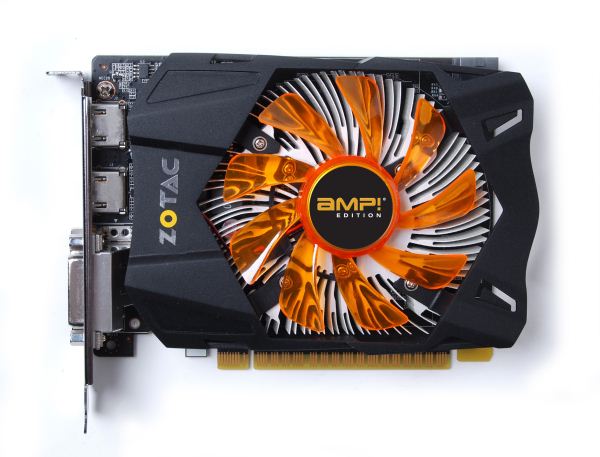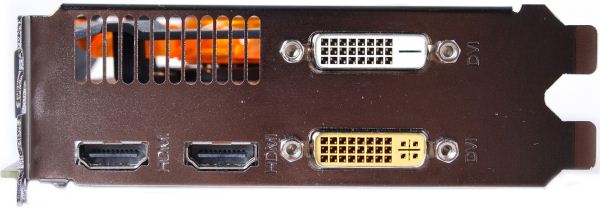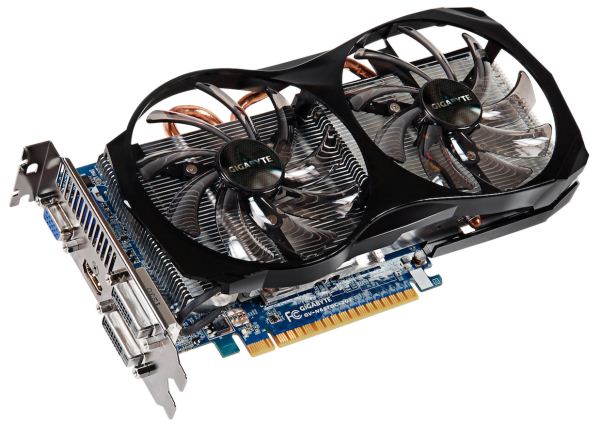
Original Link: https://www.anandtech.com/show/6359/the-nvidia-geforce-gtx-650-ti-review
The NVIDIA GeForce GTX 650 Ti Review, Feat. Gigabyte, Zotac, & EVGA
by Ryan Smith on October 9, 2012 9:00 AM EST
"Once more into the fray.
Into the last good fight I'll ever know."
-The Grey
At a pace just shy of a card a month, NVIDIA has been launching the GeForce 600 series part by part for over the last half year now. What started with the GeForce GTX 680 in March and most recently saw the launch of the GeForce GTX 660 will finally be coming to an end today with the 8th and what is likely the final retail GeForce 600 series card, the GeForce GTX 650 Ti.
Last month we saw the introduction of NVIDIA’s 3rd Kepler GPU, GK106, which takes its place between the high-end GK104 and NVIDIA’s low-end/mobile gem, GK107. At the time NVIDIA launched just a single GK106 card, the GTX 660, but of course NVIDIA never launches just one product based on a GPU – if nothing else the economics of semiconductor manufacturing dictate a need for binning, and by extension products to attach to those bins. So it should come as no great surprise that NVIDIA has one more desktop GK106 card, and that card is the GeForce GTX 650 Ti.
The GTX 650 Ti is the aptly named successor to 2011’s GeForce GTX 550 Ti, and will occupy the same $150 price point that the GTX 550 Ti launched into. It will sit between the GTX 660 and the recently launched GTX 650, and despite the much closer similarities to the GTX 660 NVIDIA is placing the card into their GTX 650 family and pitching it as a higher performance alternative to the GTX 650. With that in mind, what exactly does NVIDIA’s final desktop consumer launch of 2012 bring to the table? Let’s find out.
| GTX 660 | GTX 650 Ti | GTX 650 | GT 550 Ti | |
| Stream Processors | 960 | 768 | 384 | 192 |
| Texture Units | 80 | 64 | 32 | 32 |
| ROPs | 24 | 16 | 16 | 16 |
| Core Clock | 980MHz | 925MHz | 1058MHz | 900MHz |
| Boost Clock | 1033MHz | N/A | N/A | N/A |
| Memory Clock | 6.008GHz GDDR5 | 5.4GHz GDDR5 | 5GHz GDDR5 | 4.1GHz GDDR5 |
| Memory Bus Width | 192-bit | 128-bit | 128-bit | 192-bit |
| VRAM | 2GB | 1GB/2GB | 1GB | 1GB |
| FP64 | 1/24 FP32 | 1/24 FP32 | 1/24 FP32 | 1/12 FP32 |
| TDP | 140W | 110W | 64W | 116W |
| GPU | GK106 | GK106 | GK107 | GF116 |
| Transistor Count | 2.54B | 2.54B | 1.3B | 1.17B |
| Manufacturing Process | TSMC 28nm | TSMC 28nm | TSMC 28nm | TSMC 40nm |
| Launch Price | $229 | $149 | $109 | $149 |
Coming from the GTX 660 and its fully enabled GK106 GPU, NVIDIA has cut several features and functional units in order to bring the GTX 650 Ti down to their desired TDP and price. As is customary for lower tier parts, GTX 650 Ti ships with a binned GK106 GPU with some functional units disabled, where it unfortunately takes a big hit. For the GTX 650 Ti NVIDIA has opted to disable both SMXes and ROP/L2/memory clusters, with a greater emphasis on the latter.
On the shader side of the equation NVIDIA is disabling just a single SMX, giving GTX 650 Ti 768 CUDA cores and 64 texture units. On the ROP/L2/memory side of things however NVIDIA is disabling one of GK106’s three clusters (the minimum granularity for such a change), so coming from the GTX 660 the GTX 650 Ti will have much less memory bandwith and ROP throughput than its older sibling.
Taking a look at clockspeeds, along with the reduction in functional units there has also been a reduction in clockspeeds across the board. The GTX 650 Ti will ship at 925MHz, 65MHz lower than the GTX 660 Ti. Furthermore NVIDIA has decided to limit GPU boost functionality to the GTX 660 and higher families, so the GTX 650 Ti will actually run at 925MHz and no higher. The lack of a boost clock means the effective difference is closer to 100MHz. On the other hand the lack of min-maxing here by NVIDIA will have some good ramifications for overclocking, as we’ll see. Meanwhile the memory clock will be at 5.4GHz, which at only 600MHz below NVIDIA’s standards-bearer Kepler memory clock of 6GHz is not nearly as big as the loss of memory bandwidth from the memory bus width reduction.
Overall this gives the GTX 650 Ti approximately 72% of the shading/texturing performance, 60% of the ROP throughput, and 60% of the memory bandwidth of the GTX 660. Meanwhile compared to the GTX 650 the GTX 650 Ti has 175% of shading/texturing performance, 108% of the memory bandwidth, and 87% of the ROP throughput of its smaller predecessor. For what little tradition there is, NVIDIA’s x50 parts are traditionally geared towards 1680x1050/1600x900 resolutions. And while NVIDIA is trying to stretch that definition due to the popularity of 1920x1080 monitors, the loss of the ROP/memory cluster all but closes the door on the GTX 650 Ti’s 1080p ambitions. The GTX 650 Ti will be for all intents and purposes NVIDIA’s fastest sub-1080p Kepler card.
Moving on, it was interesting to find out that NVIDIA is not going to be disabling SMXes for the GTX 650 Ti in a straightforward manner. Because of GK106’s asymmetrical design and the pigeonhole principle – 5 SMXes spread over 3 GPCs – NVIDIA is going to be shipping GTX 650 Ti certified GPUs with both 2 GPCs and 3 GPCs, depending on which GPC houses the defective SMX that NVIDIA will be disabling. To the best of our knowledge this is the first time NVIDIA has done something like this, particularly since Fermi cards had far more SMs per GPC. Despite the fact that 3 GPC versions of the GTX 650 Ti should technically have a performance advantage due to the extra Raster Engine, NVIDIA tells us that the performance is virtually identical to the 2 GPC version. Ultimately since GTX 650 Ti is going to be ROP bottlenecked anyhow – and hence lacking the ROP throughput to take advantage of that 3rd Raster Engine – the difference should be just as insignificant as NVIDIA claims.
Meanwhile when it comes to power consumption the GTX 650 Ti is being given a TDP of 110W, some 30W lower than the GTX 660. Even compared to the GTX 550 Ti this is still a hair lower (116W vs. 110W), while the gap between the GTX 650 Ti and GTX 650 will be 34W. Idle power consumption on the other hand will be virtually unchanged, with the GTX 650 Ti maintaining the GTX 660’s 5W standard.
As NVIDIA’s final consumer desktop GeForce 600 card for the year, NVIDIA is setting the MSRP of the 1GB card at $150, between the $109 GTX 650 and the $229 GTX 660. This is another virtual launch, with partners going ahead with their own designs from the start. NVIDIA’s reference design will not be directly sold, but most of the retail boards will be very similar to NVIDIA’s reference card anyhow, implementing a single-fan open air cooler like NVIDIA’s. PCBs should also be similar; 2 of the 3 retail cards we’re looking at use the reference PCB, which on a side note is identical to the GTX 650 reference PCB as GTX 650 Ti and GTX 650 are pin compatible. Meanwhile similar to the GTX 660 Ti launch, partners will be going ahead with a mix of memory capacities, with many partners offering both 1GB and 2GB cards.
At launch the GTX 650 Ti will be facing competition from both last-generation GeForce cards and current-generation Radeon cards. The GeForce GTX 560 is currently going for almost exactly $150, making it direct competition for the GTX 650 Ti. The 560 cannot match the GTX 650 Ti’s power consumption, but thanks to its ROP performance and memory bandwidth it’s a potent competitor for rendering performance.
Meanwhile the Radeon competition will be the tag-team of the 7770 and the 7850. The 7770 is not nearly as powerful as the GTX 650 Ti, but with prices at-or-below $119 it significantly undercuts the GTX 650 Ti. Meanwhile the Pitcairn based 7850 1GB can more than give the GTX 650 Ti a run for its money, but is priced on average $20 higher at $169, and as the 1GB version is a bit of a niche product for AMD the selection the card selection won’t be as great.
To sweeten the deal NVIDIA has a new game bundle promotion starting up for the GTX 650 Ti. Retailers will be bundling vouchers for Assassin’s Creed III with GTX 650 Ti cards in North America and in Europe. Unreleased games tend to be good deals value-wise, but in the case of Assassin’s Creed III this also means waiting nearly 2 months for the PC version of the game to ship.
| Fall 2012 GPU Pricing Comparison | |||||
| AMD | Price | NVIDIA | |||
| Radeon HD 7950 | $329 | ||||
| $299 | GeForce GTX 660 Ti | ||||
| Radeon HD 7870 | $239/$229 | GeForce GTX 660 | |||
| Radeon HD 7850 2GB | $189 | ||||
| Radeon HD 7850 1GB | $169 | GeForce GTX 650 Ti 2GB | |||
| $149 | GeForce GTX 650 Ti 1GB | ||||
| Radeon HD 7770 | $109 | GeForce GTX 650 | |||
| Radeon HD 7750 | $99 | GeForce GT 640 | |||
Meet The GeForce GTX 650 Ti
Although none of NVIDIA’s partners will be selling direct copies of the NVIDIA reference design, NVIDIA did send over one of reference cards to serve as a baseline comparison (as it turns out, due to a bug you can’t underclock a GTX 650 Ti right now). Since most partner designs will closely follow NVIDIA’s reference design this actually works out for the best anyhow, as it offers a good insight into the kind of performance and design baseline we should see.
For the GeForce 600 series NVIDIA’s reference designs have been extremely solid (overclocking withstanding) and the reference GTX 650 Ti continues that tradition. The PCB itself is actually lifted from the GTX 650, which despite the difference in GPUs is pin-compatible with the GTX 650 Ti and its 128bit memory bus. This puts the length of the card at 5.75” – about as short as a PCIe x16 card can be – in a full-profile form factor. Meanwhile though taking inventory of every last electrical component isn’t practical, as near as we can tell the PCB and its components are completely identical to the reference GTX 650, which means partners are going to be able to easily drop the GTX 650 Ti into their existing GTX 650 designs so long as their cooling is adequate.
Speaking of cooling, the cooler on the reference GTX 650 Ti is a small but effective open air double-wide cooler. NVIDIA’s using a low-profile aluminum heatsink that covers roughly half the card, topped with an 80mm fan. This is the cooler style that most partners will mimic, as the 110W TDP of the GTX 650 Ti does not require a particularly large cooler; though on that note at 110W passive cooling is unlikely. As is common with open air coolers, the heatsink itself doesn’t make contact with the on-board RAM, so RAM cooling is left to airflow coming off of the fan.
NVIDIA’s RAM of choice for the GTX 650 Ti is their traditional favorite, Hynix 2Gb 6GHz GDDR5. The use of 6GHz RAM, which will be common across this family, means that the GTX 650 Ti will have some memory overclocking headroom right out of the box, memory bus willing. NVIDIA uses 4 pieces of it in a 4x32bit configuration, with 4 more pads on the back of the card for another 4 pieces for 2GB cards.
Moving on, along with losing GPU boost capabilities the GTX 650 family also gives up SLI capabilities, so unlike the GTX 550 Ti you won’t find a SLI bridge connector here. What you will find is 1 6pin PCIe power socket on the rear of the card for providing the extra power the GTX 650 needs. Meanwhile display connectivity is provided by 1 DL-DVI-I port, 1 DL-DVI-D port, and a mini-HDMI port. Since all of the Kepler GPUs support 4 displays the GTX 650 Ti can drive up to 3 displays via these connectors, and if a partner equips a card with a DisplayPort connector instead it should be possible to drive the full 4 displays off of a single GTX 650 Ti.
Meet The EVGA GeForce GTX 650 Ti Super Superclocked Edition 1GB
Our first retail card of the day and the other 1GB card in our roundup is EVGA’s GeForce GTX 650 Ti 1GB Super Superclocked Edition. This is EVGA’s factory overclocked model, with EVGA giving it a rather massive factory overclock of 146MHz (16%), pushing the shipping clockspeed to 1071MHz core while the memory clockspeed remains unchanged at 5.4GHz. Due to the size of the overclock this is one of the few occasions where EVGA skips a Superclocked card and just moves straight to Super Superclocked, which is why the GTX 650 Ti SSC doesn’t have a SC counterpart.
| GeForce GTX 650 Ti Partner Card Specification Comparison | ||||||
| GeForce GTX 650 Ti(Ref) | EVGA GTX 650 Ti SSC | Zotac GTX 650 Ti AMP! | Gigabyte GTX 650 Ti OC | |||
| Base Clock | 925MHz | 1071MHz | 1033MHz | 1033MHz | ||
| Memory Clock | 5.4GHz | 5.4GHz | 6.2GHz | 5.4GHz | ||
| Frame Buffer | 1GB | 1GB | 2GB | 2GB | ||
| Width | Double Slot | Double Slot | Double Slot | Double Slot | ||
| Length | 5.75" | 5.75" | 5.75" | 9.3" | ||
| Warranty | N/A | 3 Year | 2 Year + Life | 3 Year | ||
| Price Point | $149 | $159 | $179 | $174 | ||
Factory overclock aside, as is typical for EVGA the GTX 650 Ti SSC is very similar to NVIDIA’s reference design. Here EVGA is using the NVIDIA reference PCB but with their own cooler. EVGA’s design uses a larger, mid-profile aluminum heatsink, with a partial shroud covering it. This is still an open air cooler, but compared to the NVIDIA reference design EVGA is channeling a larger portion of air towards the card’s exhaust, which uses EVGA’s increasingly common high-flow bracket. Other than the factory overclock and the larger cooler, the GTX 650 Ti SSC is identical to the NVIDIA reference design, right down to connector placement and the display connectivity options.
Of course no EVGA card would be complete without EVGA’s software suite. EVGA has continued to update PrecisionX and OC Scanner X as newer GeForce 600 cards have come out, both of which are going to be more important than usual for the GTX 650 Ti SSC due to its overclocking capabilities. PrecisionX remains as the gold standard for video card overclocking utilities (alongside its sibling MSI Afterburner) thanks to its UI, and in this case voltage control support. OC Scanner X meanwhile is one of the best artifact scanners we’ve seen, though like other artifact scanners its ability to find problems is hit & miss; Crysis tends to trip up an overclock before OC Scanner X does.
Rounding out the rest of package is EVGA’s typical collection of accessories and knick-knacks. In the box you’ll find a molex power adapter, a quick start guide, and some stickers. As with all EVGA cards, the GTX 650 Ti SSC comes with EVGA’s standard 3 year transferable warranty, with individual 2 or 7 year extensions available for purchase upon registration, which will also unlock access to EVGA’s step-up upgrade program. Finally, the EVGA GeForce GTX 650 Ti Super Superclocked 1GB will be hitting retail with an MSRP of $159, $10 over the MSRP for reference 1GB cards. EVGA will also be offering a 2GB version of this card at $179.
Meet The Zotac GeForce GTX 650 Ti AMP! Edition 2GB
Our next card is also our first 2GB GTX 650 Ti, Zotac’s GeForce GTX 650 Ti AMP Edition 2GB. Like the other retail cards in our article the Zotac is from their factory overclocked lineup, with Zotac being unique among the bunch for overclocking both the core and the memory. The GTX 650 Ti AMP 2GB ships at 1033MHz for the core clock and 6.2GHz for the memory clock, which is a 107MHz (12%) core overclock and 800MHz (15%) memory overclock respectively. This is a lower core overclock than EVGA’s SSC, but because the GTX 650 Ti is ROP and memory bandwidth limited out of the box, the memory overclock could prove to be very potent.
The Zotac GTX 650 Ti AMP is also unique for being the only card in our review that’s not clearly based upon an NVIDIA reference design. We don’t have a Zotac GTX 650 on hand, but a quick search indicates that this is the same PCB Zotac used on their GTX 650 cards, so while Zotac is using a unique PCB it’s still a PCB taken from a GTX 650 card. With that said, Zotac’s PCB is not significantly different from the reference PCB – at 5.75” long it’s even the same size – and based on our testing it doesn’t appear to be any better or worse at overclocking, particularly since Zotac is using the same 6GHz Hynix GDDR5 as everyone else.
Zotac’s cooler of choice is also lifted from their GTX 650, and like NVIDIA’s reference design is a variation on the open air cooler. Zotac is using an 85mm fan suspended over a mid-profile aluminum heatsink that covers just over half the card. Like the reference design Zotac’s shroud is minimal, so this is a rather typical open air design.
Meanwhile by changing the PCB Zotac was able to change the display ports on their card, opting to use a stacked DVI design to fit on 4 ports. The GTX 650 Ti AMP comes with 1 DL-DVI-I, 1 DL-DVI-D, and 2 full size HDMI ports, meaning it can drive 4 digital displays out of the box. The dual HDMI ports is a bit odd – we don’t see too many users hooking the card up to two TVs – and in this case the HDMI ports are serving more as a compact SL-DVI port. This change also means that part of the second slot is blocked by a DVI port, so the card has less than a slot’s worth of ventilation (not that it should need too much more).
Rounding out the package is the usual collection of a molex power adapter and quickstart guides. Zotac is attaching a $179 MSRP to the GeForce GTX 650 Ti AMP, a full $30 over the 1GB MSRP, but only $10 over what they’re changing for a stock-clocked 2GB card. Meanwhile for the warranty Zotac is offering a base 2 year warranty, which is extended to a rather generous full limited lifetime warranty upon registration of the card.
Meet The Gigabyte GeForce GTX 650 Ti OC 2GB Windforce
Our final card of the day is Gigabyte’s entry, the GeForce GTX 650 Ti OC 2GB. Like the other cards in today’s review this is a factory overclocked model, with Gigabyte shipping the core clock at 1033MHz, 107MHz (12%) over reference and the same overclock as Zotac. Meanwhile the memory clock is unchanged at 5.4GHz.
With the weakest factory overclock of the bunch, Gigabyte’s claim to fame here will be their design, which significantly deviates from NVIDIA’s reference design. The PCB itself is clearly based on NVIDIA’s (right down to the 5.75” length) and is otherwise unremarkable, but Gigabyte’s cooler is another Windforce 2X cooler, making it significant different from the much smaller open air coolers on the rest of the cards we’ve seen. Though the design of the cooler in use depends on the specific model of card, all of Gigabyte’s Windforce coolers share the same basic design, featuring a long aluminum heatsink that runs the length of the card (if not beyond), attached to the GPU through the use of copper heatpipes (2 in the case of the GTX 650 Ti).
Meanwhile air movement is provided by a pair of ridiculously large 100mm fans that run the length of the heatsink. In fact “ridiculously large” is about the single best two-word description there is for the GTX 650 Ti OC’s Windforce cooler. As we’ll see it’s going to be very effective, but in all likelihood it’s overkill out of the box. Because of the length (and significant overhang) of the Windforce cooler, Gigabyte’s card measures 9.3” long and you’ll need an extra inch of vertical clearance too to fit the behemoth.
Outside of cooling, Gigabyte’s card is otherwise very typical for a GTX 650 Ti. Gigabyte has equipped the card 2GB of Hynix 6GHz GDDR5, so when you overclock – and with a cooler this big you must – there is at a minimum a fair bit of memory headroom to play with. Meanwhile along with the minor PCB changes Gigabyte has changed the display ports to fit their needs. Gigabyte’s card uses a stacked DL-DVI-D design, augmenting that with a full-size HDMI port and a VGA port. With the increasing performance and ubiquity of iGPUs, VGA ports have finally started to fall out of favor, so Gigabyte is alone in shipping their card with a VGA port instead of a DVI-I to VGA dongle.
Rounding out the package is the usual collection of power adapters and a quick start guide. While it’s not included in the box or listed on the box, the Gigabyte GeForce GTX 650 Ti OC works with Gigabyte’s OC Guru II overclocking software, which is available on Gigabyte’s website. OC Guru isn’t quite up to the gold standard of overclocking software, but it’s functional, sleek, and gets the job done, which is great as with a cooler this large this card demands to be overclocked.
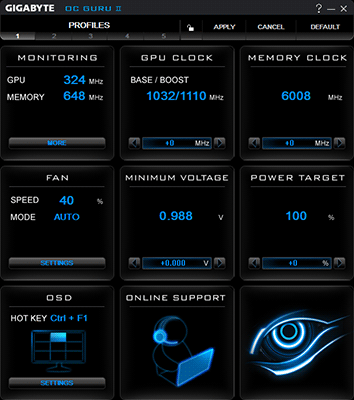
Wrapping things up, the Gigebyte GeForce GTX 650 Ti OC comes with Gigabyte’s standard 3 year warranty. Gigabyte will be releasing it at an MSRP of $174 ($169 without AC3), $25 over the price of a reference-clocked GTX 650 Ti and $5 less than the most expensive card in our roundup today.
The 2GB Question & The Test
If it seems to like 1GB+ video cards have been common for ages now, you wouldn’t be too far off. 1GB cards effectively became mainstream in 2008 with the release of the 1GB Radeon HD 4870, which was followed by 2GB cards pushing out 1GB cards as the common capacity for high-end cards in 2010 with the release of the Radeon HD 6970. Since then 2GB cards have been trickling down AMD and NVIDIA’s product stacks while at the same time iGPUs have been making the bottoms of those stacks redundant.
For this generation AMD decided to make their cutoff the 7800 series earlier this year; the 7700 series would be 1GB by default, while the 7800 series and above would be 2GB or more. AMD has since introduced the 7850 1GB as a niche product (in large part to combat the GTX 650 Ti), but the 7850 is still predominantly a 2GB card. For NVIDIA on the other hand the line is being drawn between the GTX 660 and GTX 650; the GTX 660 is entirely 2GB, while the GTX 650 and GTX 650 Ti are predominantly 1GB cards with some 2GB cards mixed in as a luxury option.
The reason we bring this up is because while this is very clear from a video card family perspective, it doesn’t really address performance expectations. Simply put, at what point does a 2GB card become appropriate? When AMD or NVIDIA move a whole product line the decision is made for you, but when you’re looking at a split product like the GTX 650 Ti or the 7850 then the decision is up to the buyer and it’s not always an easy decision.
To try to help with that decision, we’ve broken down the performance of several games on both cards with both 1GB and 2GB models, listing the performance of 2GB cards relative to 1GB cards. By looking for performance advantages, we can hopefully better quantify the benefits of a 2GB card.
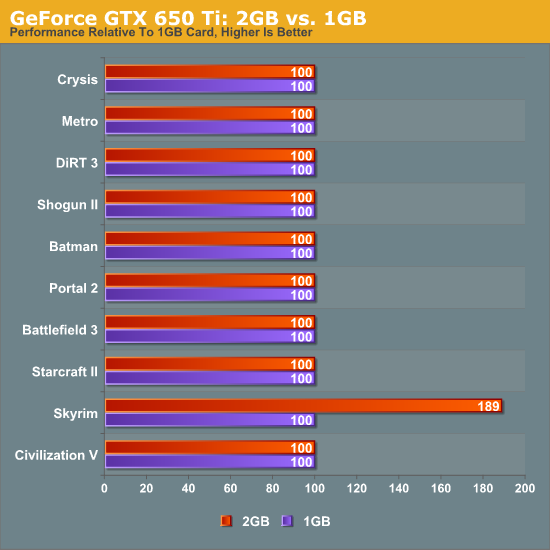
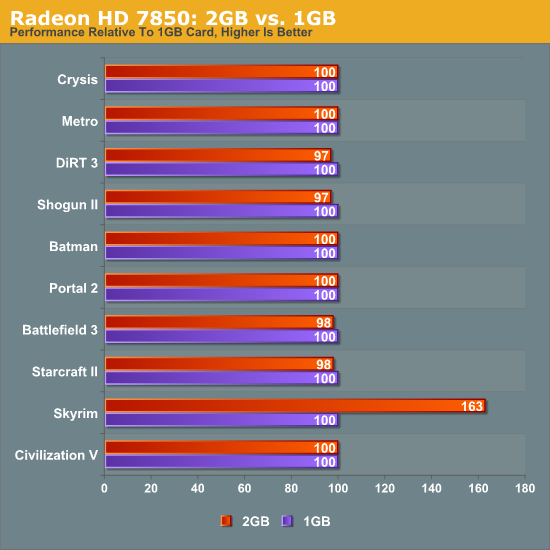
Regardless of whether we’re looking at AMD or NVIDIA cards, there’s only one benchmark where 2GB cards have a clear lead: Skyrim at 1920 with the high resolution texture pack. For our other 9 games the performance difference is miniscule at best.
But despite the open-and-shut nature of our data we’re not ready to put our weight behind these results. Among other issues, our benchmark suite is approaching a year old now, which means it doesn’t reflect on some of the major games released in the past few months such as XCOM: Enemy Unknown, Borderlands 2, DiRT: Showdown, or for that matter any one of the number of games left to be released this year. While we have full confidence in our benchmark suite from a competitive performance perspective, the fact that it’s not forward looking (and mostly forward rendering) does a disservice to measuring the need for additional memory.
The fact of the matter is that while the benchmarks don’t necessarily show it, along with Skyrim we’ve seen Crysis clobber 1GB cards in the past, Shogun II’s highest settings won’t even run on a 1GB card, and at meanwhile Battlefield 3 scales up render distance with available video memory. Nearly half of our benchmark games do benefit from 2GB cards, a subjective but important quality.
So despite the fact that our data doesn’t immediately show the benefits of 2GB cards, our thoughts go in the other direction. As 2012 comes to a close, cards that can hit the GTX 650 Ti’s performance level are not well equipped for future with only 1GB of VRAM. 1GB is the cheaper option – and at these prices every penny counts – but it is our belief that by this time next year 1GB cards will be in the same place 512MB cards were in 2010: bottlenecked by a lack of VRAM. We have reached that point where if you’re going to be spending $150 or more that you shouldn’t be settling for a 1GB card; this is the time where 2GB cards are going to become the minimum for performance gaming video cards.
The Test
NVIDIA’s GTX 650 Ti launch driver is 306.38, which are a further continuation of the 304.xx branch. Compared to the previous two 304.xx drivers there are no notable performance changes or bug fixes that we’re aware of.
Meanwhile on the AMD side we’re using AMD’s newly released 12.9 betas. While these drivers are from a new branch, compared to the older 12.7 drivers the performance gains are minimal. We have updated our results for our 7000 series cards, but the only difference as it pertains to our test suite is that performance in Shogun II and DiRT 3 is slightly higher than with the 12.7 drivers.
On a final note, AMD sent over XFX’s Radeon HD 7850 1GB card so that we had a 1GB 7850 to test with (thanks guys). As this is not a new part from a performance perspective (see above) we’re not doing anything special with this card beyond including it in our charts as validation of the fact that the 1GB and 2GB 7850s are nearly identical outside of Skyrim.
| CPU: | Intel Core i7-3960X @ 4.3GHz |
| Motherboard: | EVGA X79 SLI |
| Chipset Drivers: | Intel 9.2.3.1022 |
| Power Supply: | Antec True Power Quattro 1200 |
| Hard Disk: | Samsung 470 (256GB) |
| Memory: | G.Skill Ripjaws DDR3-1867 4 x 4GB (8-10-9-26) |
| Case: | Thermaltake Spedo Advance |
| Monitor: | Samsung 305T |
| Video Cards: |
AMD Radeon HD 5770 AMD Radeon HD 6850 AMD Radeon HD 7770 AMD Radeon HD 7850 1GB AMD Radeon HD 7850 2GB NVIDIA GeForce GTS 450 NVIDIA GeForce GTX 550 Ti NVIDIA GeForce GTX 560 NVIDIA GeForce GTX 650 NVIDIA GeForce GTX 650 Ti NVIDIA GeForce GTX 660 |
| Video Drivers: |
NVIDIA ForceWare 305.37 NVIDIA ForceWare 306.23 Beta NVIDIA ForceWare 306.38 Beta AMD Catalyst 12.9 Beta |
| OS: | Windows 7 Ultimate 64-bit |
Crysis: Warhead
Kicking things off as always is Crysis: Warhead. It’s no longer the toughest game in our benchmark suite, but it’s still a technically complex game that has proven to be a very consistent benchmark. Thus even four years since the release of the original Crysis, “but can it run Crysis?” is still an important question, and the answer continues to be “no.” While we’re closer than ever, sub-$200 cards still struggle to hit 60fps at 1680x1050, never mind 1080p.
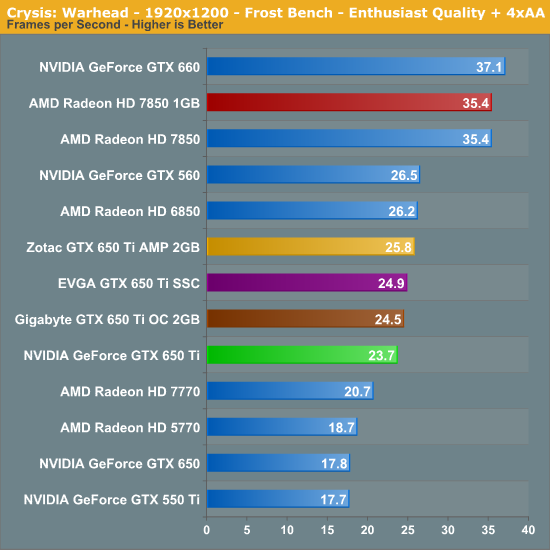
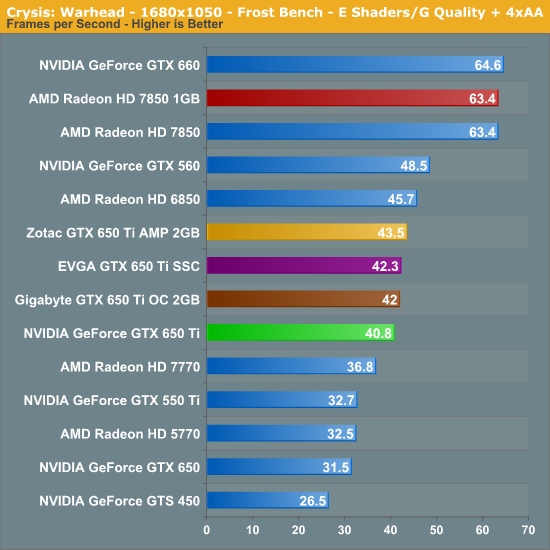
Crysis is a game that has consistently fouled up NVIDIA’s GeForce 600 cards, and this is especially evident with the launch of the GTX 650 Ti. The performance difference makes this a no-contest bout; the 7850 is nearly 50% faster. GTX 650 Ti doesn’t stand a chance here. At best you’re looking at a 42fps average for the GTX 650 Ti at 1680, which is a far cry from the 60fps smoothness the 7850 can deliver.
Meanwhile looking at our retail factory overclocked cards, all of them improve on Crysis’s performance, but not by nearly enough. Because this game is memory bandwidth limited at times, the Zotac GTX 650 Ti AMP with its memory overclock is the winner here, squeezing out the Gigabyte and EVGA cards with their reference memory clocks.
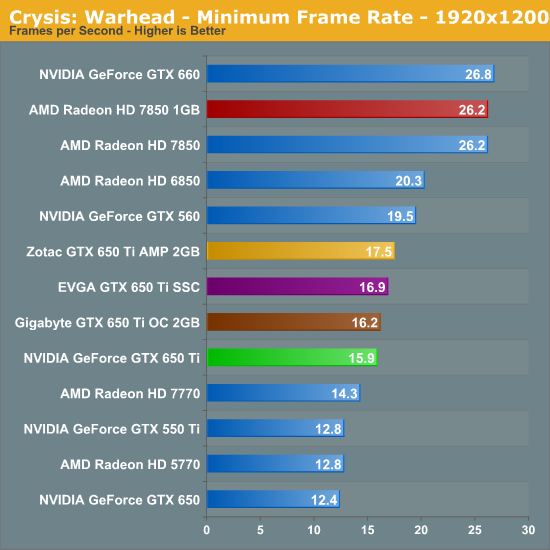
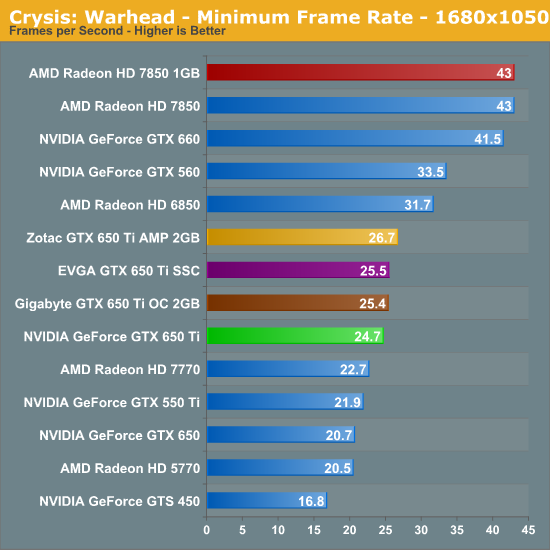
As bad as the averages were for the GTX 650 Ti, the minimums are even worse. At 1680 the GTX 650 Ti is only hitting 57% of the performance of the 7850 1GB; it doesn’t even crack 30fps.
Metro: 2033
Paired with Crysis as our second behemoth FPS is Metro: 2033. Metro gives up Crysis’ lush tropics and frozen wastelands for an underground experience, but even underground it can be quite brutal on GPUs, which is why it’s also our new benchmark of choice for looking at power/temperature/noise during a game. If its sequel due this year is anywhere near as GPU intensive then a single GPU may not be enough to run the game with every quality feature turned up.
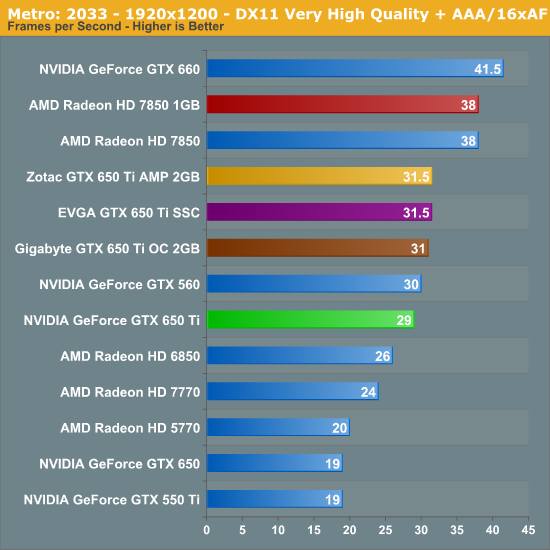
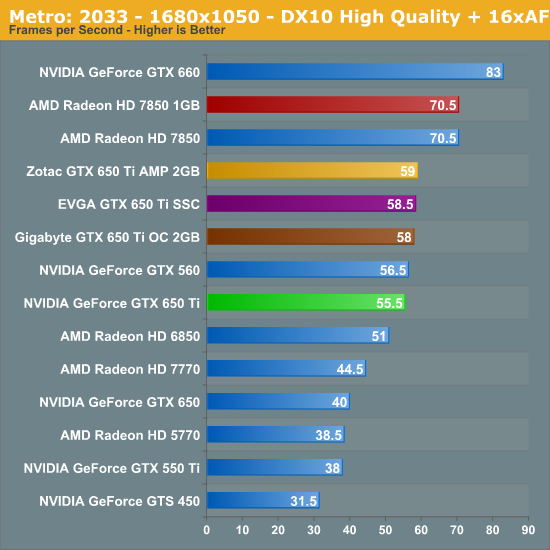
The good news for the GTX 650 Ti is that Metro is not the performance bloodbath that Crysis was. The bad news is that this is just about all the GTX 650 Ti has going for it. The Radeon HD 7850 1GB is priced above the GTX 650 Ti and for good reason: it’s faster. At $20 more expensive the cutoff is basically 13%; if the 7850 can lead by more than 13%, it’s outpacing the GTX 650 Ti even after accounting for the price difference. In this case the 7850 leads by 26%, double the magic number. At best you can say the GTX 650 Ti isn’t doing too poorly here on an absolute basis, since it’s within striking distance of 60fps.
As for our factory overclocked cards, once again we see Zotac pull ahead of EVGA and Gigabyte in that order. Despite the fact that each card has a different factory overclock, the difference between the overclocks is small enough that there’s not any kind of significant gap between the cards. Unfortunately even the Zotac card with its duo of memory and core overclocking still falls just short of 60fps here.
DiRT 3
For racing games our racer of choice continues to be DiRT, which is now in its 3rd iteration. Codemasters uses the same EGO engine between its DiRT, F1, and GRID series, so the performance of EGO has been relevant for a number of racing games over the years.
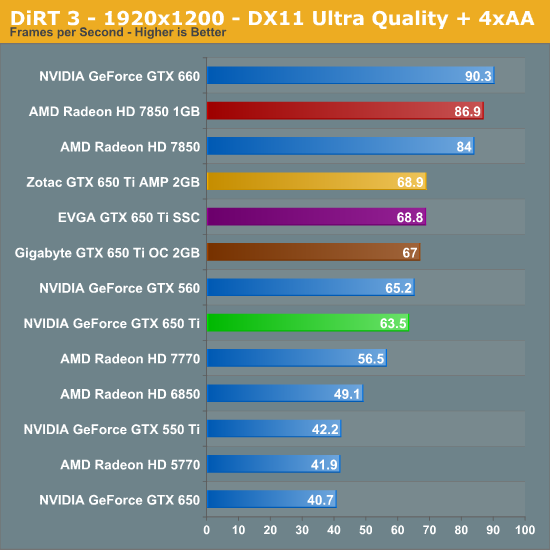
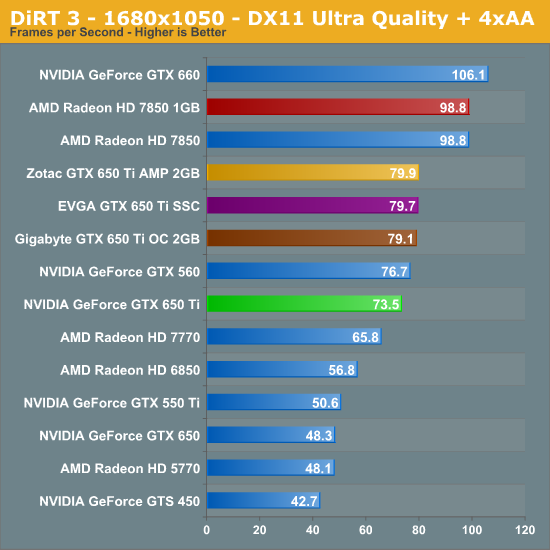
On an absolute basis, the GTX 650 Ti does well enough here, keeping the average framerate above 60fps even at the 1920x1200, a resolution it would typically have trouble with. But on a competitive basis this is another struggle for the GTX 650 Ti, as the 7850 passes it by 33%. Adding insult to injury, the 7770 – a card not even in the same league as the GTX 650 Ti – only trails the GTX 650 Ti by 10%.
Meanwhile the factory overclocked cards can help to close the gap, but at the same time their higher prices serve to erode the GTX 650 Ti’s price advantage. Once more all of these cards are close, with the Zotac edging out the rest.
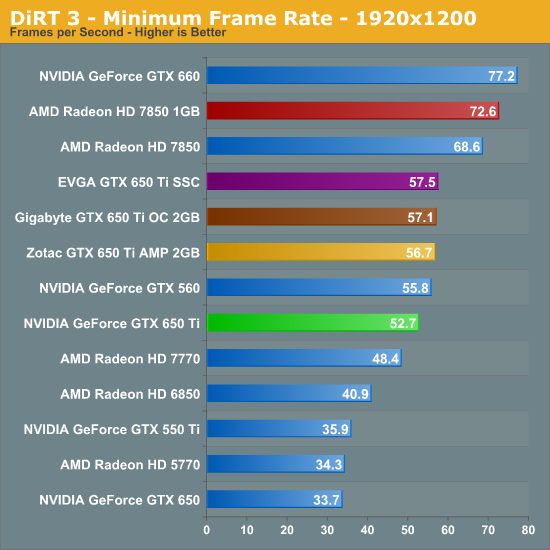
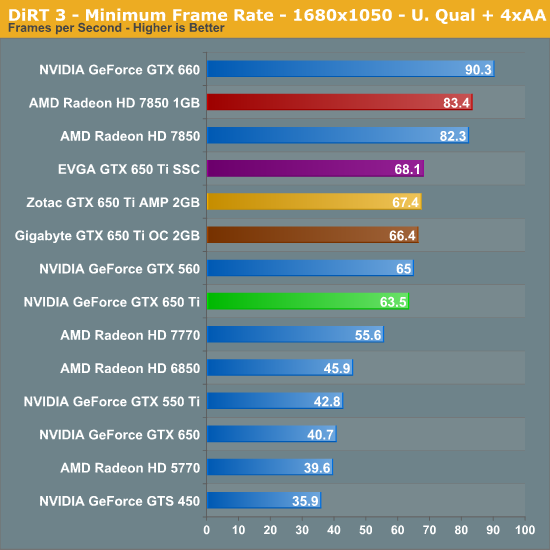
Looking at minimum framerates it’s a similar scenario as with the average framerates. The 7850 is well in the lead, though at 1680 the GTX 650 Ti is hitting minimum framerates above 60fps. Interestingly the ordering of our factory overclocked cards changes slightly; the EVGA card and its top factory overclock now edge out Zotac and Gigabyte, giving us a game where Zotac’s memory overclock isn’t enough to overtake a larger core overclock.
Total War: Shogun II
Total War: Shogun 2 is the latest installment of the long-running Total War series of turn based strategy games, and alongside Civilization V is notable for just how many units it can put on a screen at once. As it also turns out, it’s the single most punishing game in our benchmark suite (on higher end hardware at least).
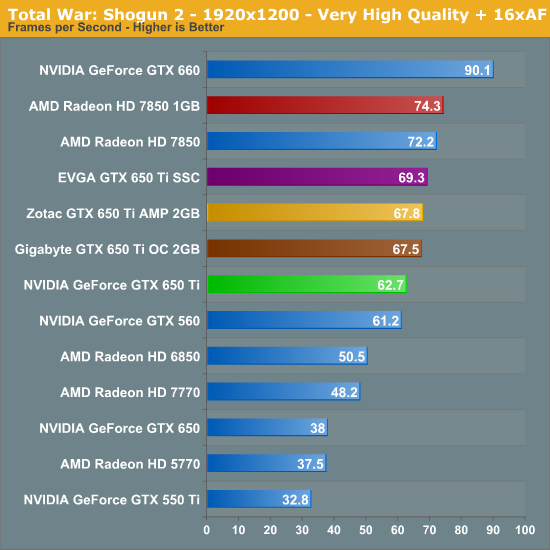
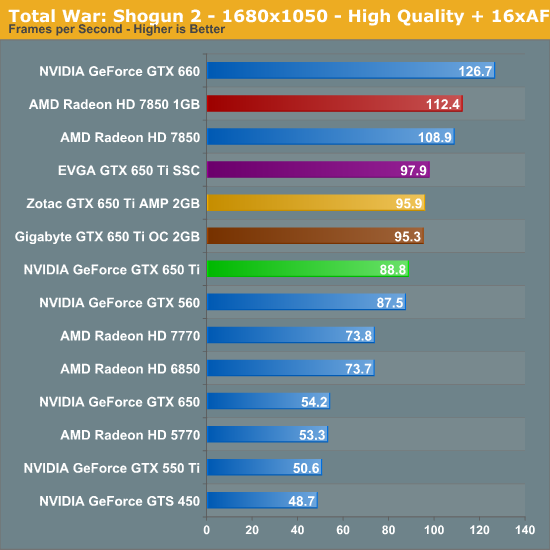
After the troubles it’s had in our earlier games, the GTX 650 Ti is improving its situation a bit here. Despite the limited amount of RAM on it, it still passes 60fps even at 1920. Furthermore the 7850’s lead has waned here, with the 7850 leading by only 23% at 1680 and an even smaller 15% at 1920. None the less this means the 7850 is covering the spread, which is not great news for NVIDIA.
At this point if it hasn’t become obvious, the 7850 is in its own class, much like the GTX 650 Ti sits above the 7700 in its own class. The GTX 650 Ti can’t win and it can barely tie; whether it’s a worthwhile card or not is going to depend on how close it can get to the 7850 given the price difference between the two.
As for our factory overclocked GTX 650 Ti cards, this time we see a full reversal of earlier trends with the EVGA card taking a lead, owing to its greater core overclock.
Batman: Arkham City
Batman: Arkham City is loosely based on Unreal Engine 3, while the DirectX 11 functionality was apparently developed in-house. With the addition of these features Batman is far more a GPU demanding game than its predecessor was, particularly with tessellation cranked up to high.
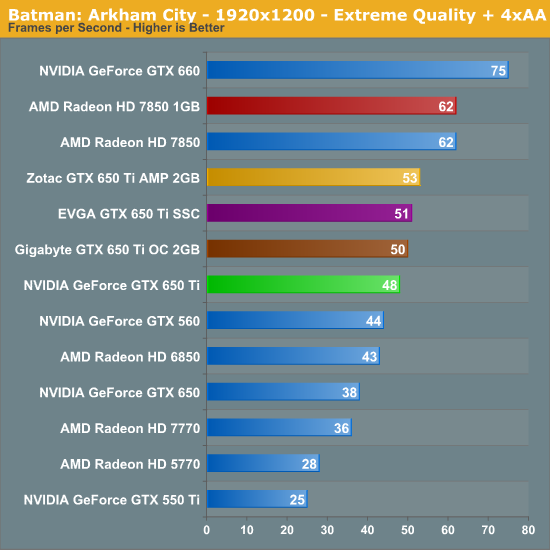
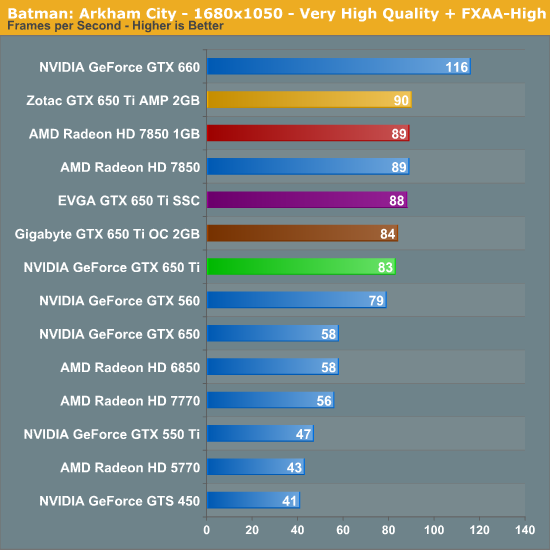
With Batman the GTX 650 Ti finally makes some significant progress into cutting into the lead of the 7850. At 1680 leads by just 7%, which translates into 6fps and half the earlier spread we established. At these settings we’re not using MSAA, so if nothing else the 7850 does not get to utilize its typical memory bandwidth and ROP throughput advantages. That becomes especially evident at 1920, which otherwise drives a large wedge in between the two cards.
Meanwhile our factory overclocked cards don’t just close the 7850 gap, but for the first time push past it. At 90fps the Zotac GTX 650 Ti AMP is just fast enough to surpass the 7850, an important accomplishment not just for the GTX 650 Ti in general, but for validating the more expensive factory overclocked cards.
Portal 2
Portal 2 continues the long and proud tradition of Valve’s in-house Source engine. While Source continues to be a DX9 engine, Valve has continued to upgrade it over the years to improve its quality, and combined with their choice of style you’d have a hard time telling it’s over 7 years old at this point. Consequently Portal 2’s performance does get rather high on high-end cards, but we have ways of fixing that…
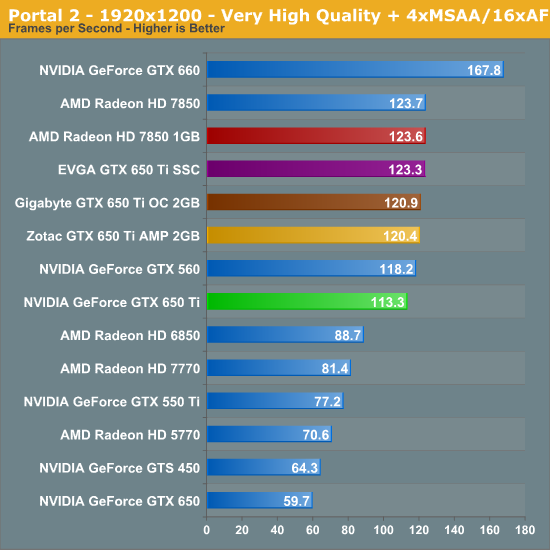
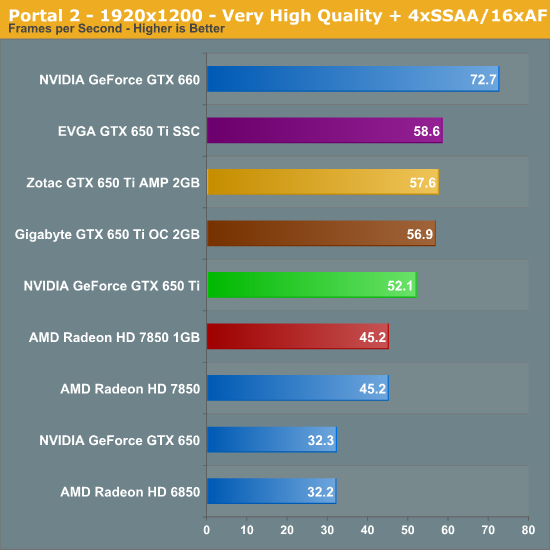
With Portal 2 it’s not a matter of whether 1920x1200 is playable, but rather whether it’s playable with SSAA or just MSAA. In the case of the GTX 650 Ti, it’s just shy of being able to crack 60fps with SSAA, which is a good 15% better than what the 7850 can do. NVIDIA has always held an advantage in this benchmark with SSAA, and that advantage has cascaded into one of the only times the GTX 650 Ti can outright beat the 7850. Of course if we turn off SSAA we’ll see the 7850 lurch back ahead, but even then it’s only a 9% lead on behalf of the 7850.
Meanwhile the factory overclocked cards further add to the GTX 650 Ti’s lead. They also give us a good idea of what the bottleneck is for the GTX 650 Ti; rather than being memory bandwidth it would appear to be shading performance or ROP throughput.
Battlefield 3
Its popularity aside, Battlefield 3 may be the most interesting game in our benchmark suite for a single reason: it’s the first AAA DX10+ game. It’s been 5 years since the launch of the first DX10 GPUs, and 3 whole process node shrinks later we’re finally to the point where games are using DX10’s functionality as a baseline rather than an addition. Not surprisingly BF3 is one of the best looking games in our suite, but as with past Battlefield games that beauty comes with a high performance cost.
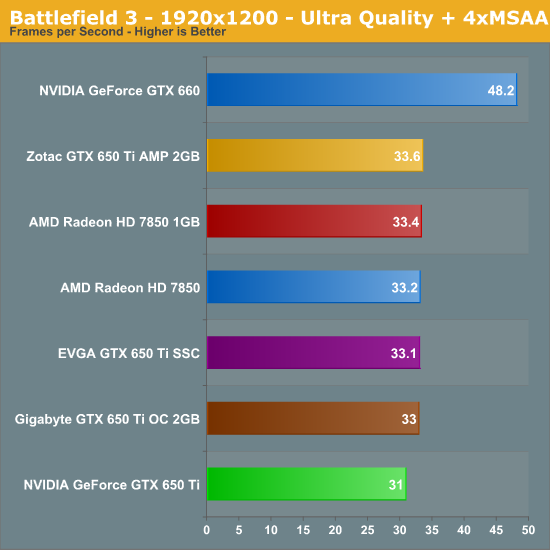
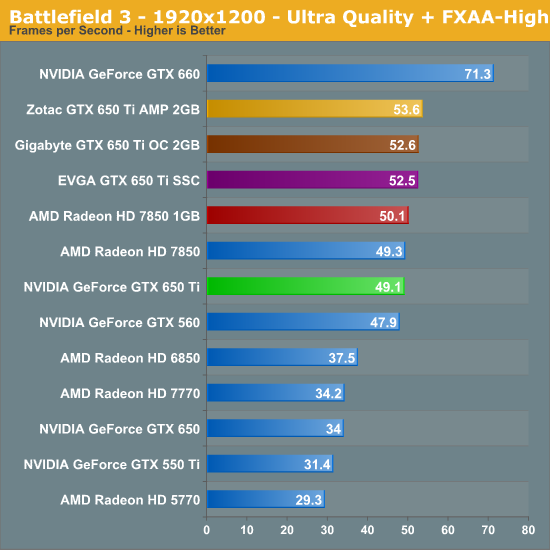
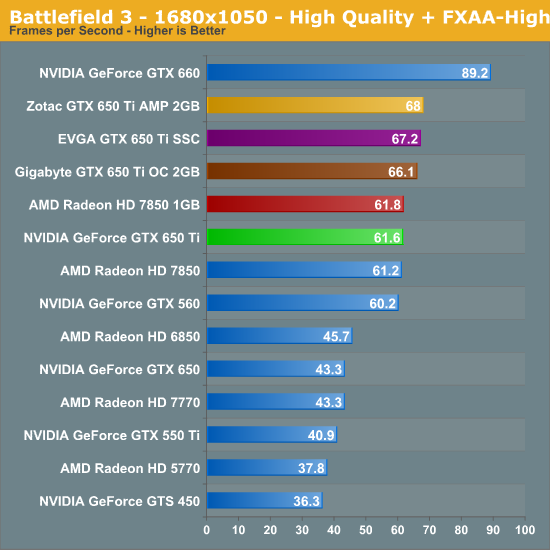
Battlefield 3 is the game that really drives home the point that the GTX 650 Ti isn’t well suited for 1920x1200 with top quality settings. We have to get down to 1680x1050 with high quality (a notch below ultra) in order to get our framerate above 60fps, a prerequisite for keeping it from bottoming out below 30fps in large multiplayer firefights. To that end the GTX 650 Ti is fast enough (if just barely) to hit the kind of solid framerates needed for Battlefield 3.
With Battlefield 3 being another game that has typically favored NVIDIA’s architectures, the results of our benchmarks may or may not come as a great surprise. Typically NVIDIA’s cards have enjoyed 10%+ leads, but not this time. Instead the GTX 650 Ti and the 7850 are in a dead heat, posting framerates within a fraction of each other. On the other hand, given the fact that the GTX 650 Ti is being sold as a slower, lower priced card than the 7850, the fact that it can tie the 7850 here is quite remarkable. The kind of lopsided performance we’re seeing today means that the comparable AMD and NVIDIA cards aren’t going back and forth on a game-by-game basis, but it doesn’t have to be a blowout either.
Meanwhile the factory overclocked cards build upon that tie and push past the reference GTX 650 Ti and the 7850. Once more the Zotac takes the lead thanks to its combined overclock, followed by the EVGA card and finally the Gigabyte card.
On a side note, we haven’t really discussed the GeForce 500 series before now, so let’s do that. On the one hand, despite the GTX 650 Ti’s difficulties versus the 7850, one thing NVIDIA has clearly been able to do is to rocket past the GTX 550 Ti. At a year and a half old it’s not direct competition, but it shows that compared to some milder gains over past-generation cards on the high-end, NVIDIA’s mid-to-low cards are seeing greater gains. On the other hand the GTX 550 Ti was an overpriced card when it launched, so this also isn’t a ringing endorsement.
On the other hand the performance compared to the GTX 560 isn’t particularly enthusing. The GTX 650 Ti is never really passing the GTX 560 in performance, and while the GTX 560 is an outgoing card it means that at launch the GTX 650 Ti isn’t offering anything on the price/performance curve the GTX 560 wasn’t already hitting.
Starcraft II
Our next game is Starcraft II, Blizzard’s 2010 RTS megahit. Much like Portal 2 it’s a DX9 game designed to run on a wide range of hardware so performance is quite peppy with most high-end cards, but it can still challenge a GPU when it needs to.
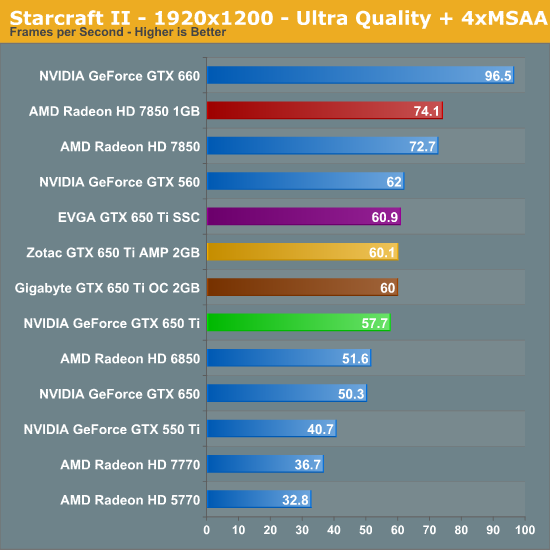
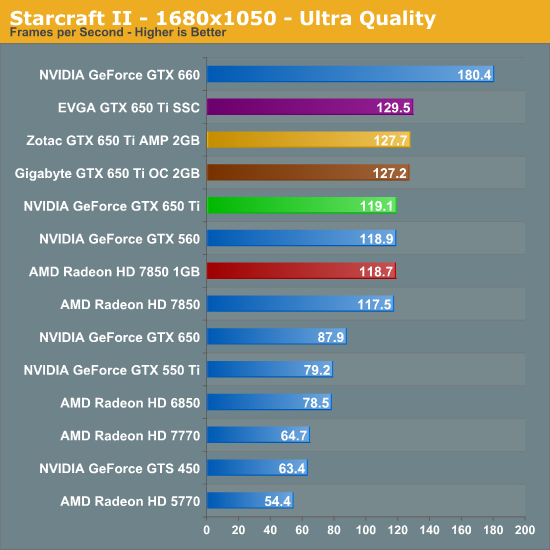
As opposed to Battlefield 3, Starcraft II is light enough that the GTX 650 Ti can generally get away with 1920x1200, even with MSAA. It isn’t 60fps, but for a RTS it’s good enough. The bad news from this view is that while the GTX 650 Ti falls short of 60fps the 7850 can blow past it. Otherwise at 1680x1050 without MSAA we see something similar to Batman, where the GTX 650 Ti hangs with the 7850 as these lower settings do not penalize the GTX 650 Ti’s lack of ROP throughput and memory bandwidth nearly as hard.
Meanwhile the factory overclocked cards see the typical performance gains. Without memory bandwidth being hit so hard, it’s the EVGA card and its top core overclock that edges out the others. Notably, all 3 can just hit 60fps at 1920.
The Elder Scrolls V: Skyrim
Bethesda's epic sword & magic game The Elder Scrolls V: Skyrim is our RPG of choice for benchmarking. It's altogether a good CPU benchmark thanks to its complex scripting and AI, but it also can end up pushing a large number of fairly complex models and effects at once, especially with the addition of the high resolution texture pack.
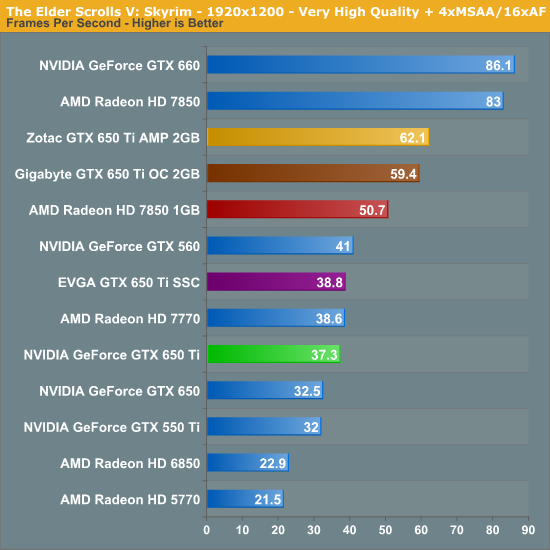
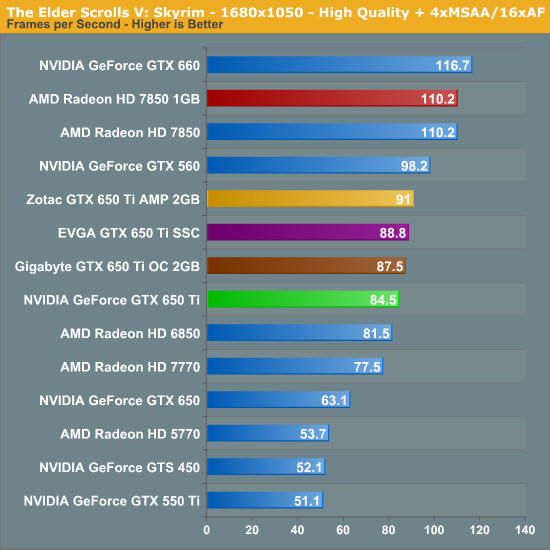
Skyrim with its optional high resolution texture pack is the textbook case for 2GB cards right now. At 1680x1050 (with lower quality settings) matters aren’t so bad, but at 1920x1200 1GB cards flat out run out of VRAM. This goes for both the GTX 650 Ti 1GB and the 7850 1GB, leaving the field to 2GB cards such as the 7850 2GB and the 2GB factory overclocked retail cards. To that end with enough VRAM the GTX 650 Ti cards can just hit 60fps with their factory overclocks, but the 7850 2GB, which was already just trailing the GTX 660, is well ahead.
Dropping down to 1680x1050 is enough to mitigate the lack of VRAM, but even then the GTX 650 Ti doesn’t fair particularly well. On an absolute basis it’s at 84fps, which is more than smooth, but the 7850 still enjoys a 30% lead. On that note, along with a lack of total VRAM, a lack of memory bandwidth seems to really be hammering the GTX 650 Ti, which is why we not only see the Zotac card pop to the head of that pack, but is why the 7850 and even the GTX 560 do so well here.
Civilization V
Our final game, Civilization 5, gives us an interesting look at things that other RTSes cannot match, with a much weaker focus on shading in the game world, and a much greater focus on creating the geometry needed to bring such a world to life. In doing so it uses a slew of DirectX 11 technologies, including tessellation for said geometry, driver command lists for reducing CPU overhead, and compute shaders for on-the-fly texture decompression.
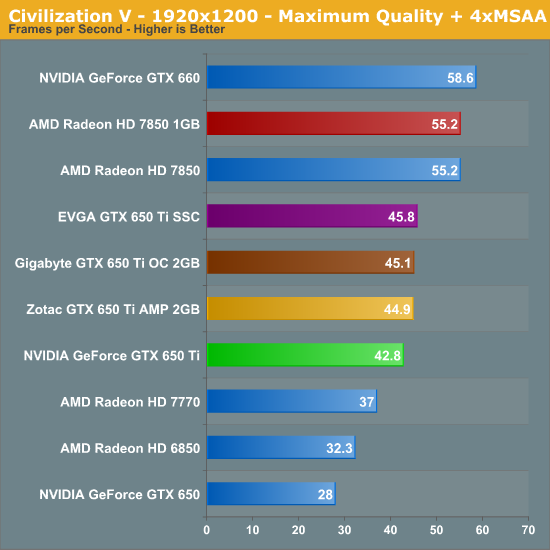
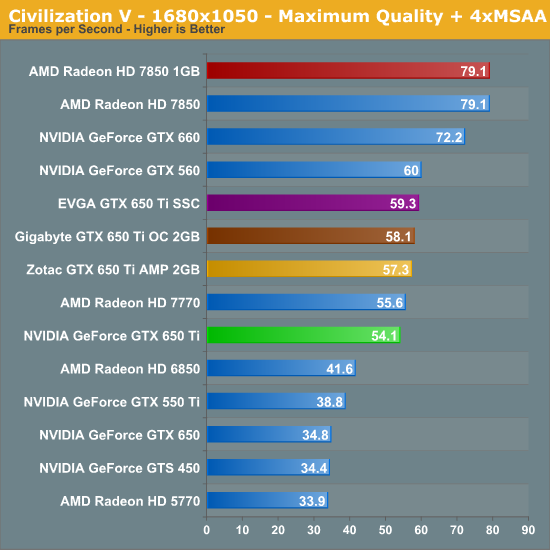
Just as how the GTX 650 Ti went into these game benchmarks behind the competition, so will it leave. At 1680 the 7850 enjoys a massive 46% lead, similar to the massive lead it had at the start with Crysis. Interestingly that lead greatly diminishes at 1920 where it becomes 28%, but that’s still more than twice the 13% price spread.
Looking to our factory overclocked cards, the EVGA card comes out on top if only by a hair, indicating that the GTX 650 Ti’s biggest bottleneck at the moment is either shader or ROP throughput.
Compute Performance
As always our final set of real-world benchmarks is composed of a look at compute performance. As we have seen with GTX 680 other Kepler cards, Kepler appears to be significantly less balanced between rendering and compute performance than GF110 or GF114/GF116 were, and as a result compute performance suffers. On the other hand, relative to the GTX 660 the GTX 650 Ti sacrifices a smaller portion of its compute performance than its ROP/L2/memory performance, so this may bode better for computer performance.
Our first compute benchmark comes from Civilization V, which uses DirectCompute to decompress textures on the fly. Civ V includes a sub-benchmark that exclusively tests the speed of their texture decompression algorithm by repeatedly decompressing the textures required for one of the game’s leader scenes. Note that this is a DX11 DirectCompute benchmark.
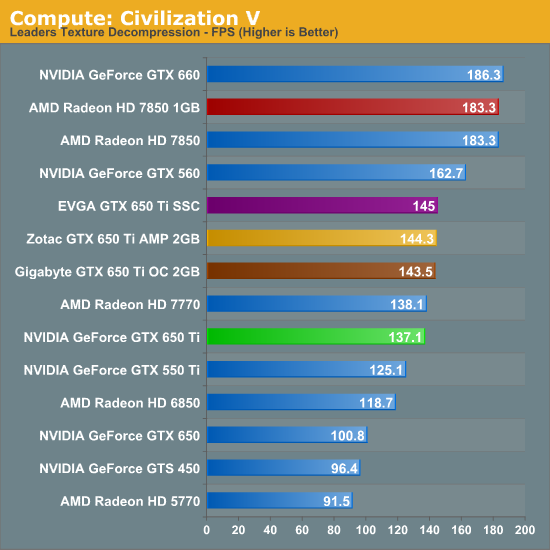
There really isn’t a lot to say here. The GTX 650 Ti is only slightly ahead of the GTX 550 Ti, never mind the GTX 560. Worse, it’s tied with the 7770 and well behind the 7850. Given the nature of the test, with cards on memory busses this small I believe we’ve run into a proxy test for memory bandwidth rather than compute throughput. Which just goes to show that all of that compute throughput is meaningless without the memory bandwidth and cache to feed the best.
Our next benchmark is SmallLuxGPU, the GPU ray tracing branch of the open source LuxRender renderer. We’re now using a development build from the version 2.0 branch, and we’ve moved on to a more complex scene that hopefully will provide a greater challenge to our GPUs.
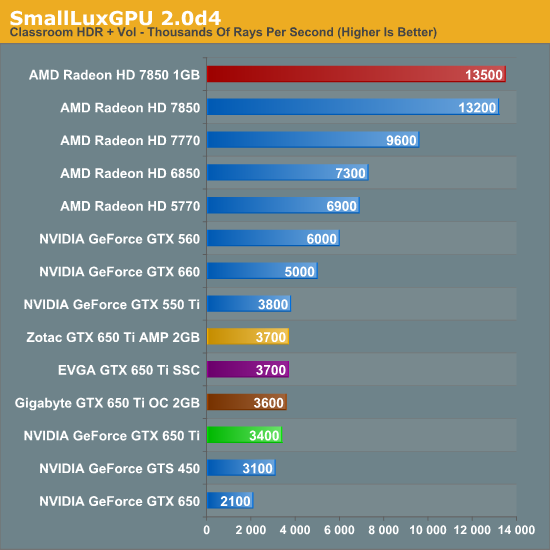
Not surprisingly, the GTX 650 Ti loses to just about everything. SmallLuxGPU’s OpenCL renderer just doesn’t mesh well with Kepler and NVIDIA’s drivers. The resulting lead for the 7850 is nothing short of massive.
For our next benchmark we’re looking at AESEncryptDecrypt, an OpenCL AES encryption routine that AES encrypts/decrypts an 8K x 8K pixel square image file. The results of this benchmark are the average time to encrypt the image over a number of iterations of the AES cypher.
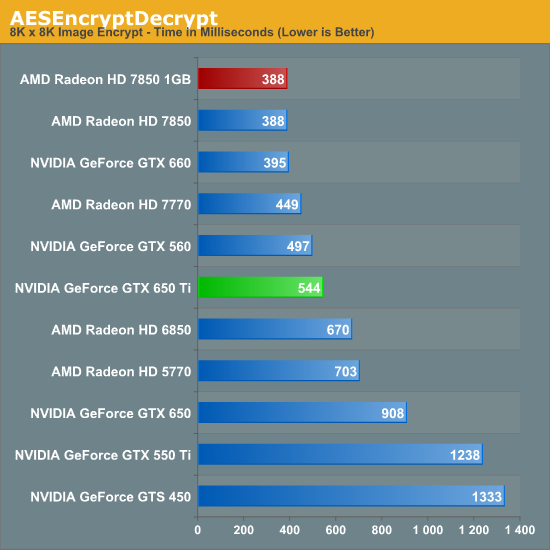
Unlike our previous OpenCL benchmark the GTX 650 Ti’s showing isn’t nearly as bad, but neither is it great. Both the GTX 560 and the 7770 are in the lead, but at least the improvement over the GTX 550 Ti is nothing short of amazing. At times NVIDIA’s problem isn’t where GTX 650 Ti is compared to last-generation cards, but rather it is compared to AMD’s strong Radeon HD 7000 series lineup.
Our fourth benchmark is once again looking at compute shader performance, this time through the Fluid simulation sample in the DirectX SDK. This program simulates the motion and interactions of a 16k particle fluid using a compute shader, with a choice of several different algorithms. In this case we’re using an (O)n^2 nearest neighbor method that is optimized by using shared memory to cache data.
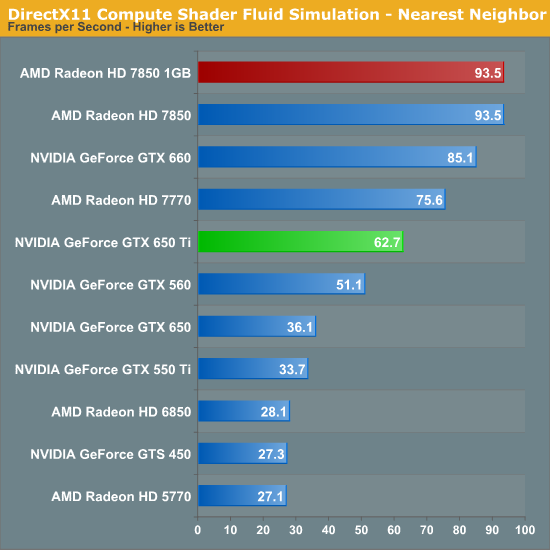
Once more the GTX 650 Ti is in trouble. It can beat the GeForce 500 series, but even the 7770 is faster.
Finally, we’ll take a look at one last benchmark to our compute run with the benchmarkable version of the Folding@Home client. Folding@Home and similar initiatives are still one of the most popular consumer compute workloads, so it’s something NVIDIA wants their GPUs to do well at.
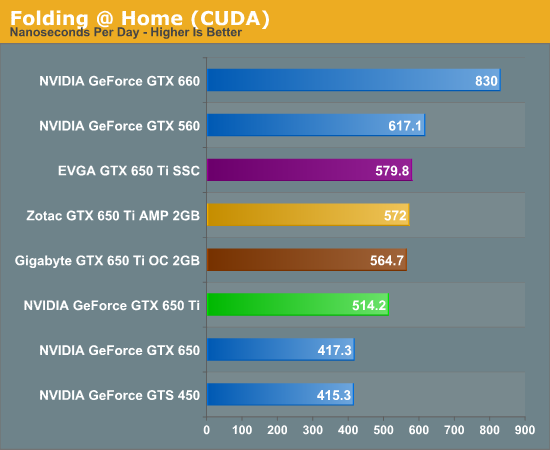
Here’s another case where memory bandwidth and L2 cache appear to be a problem. The GTX 650 Ti is much farther behind the GTX 660 than we would have expected, and even the GTX 560 can take a lead here. On the other hand memory bandwidth bottlenecking isn’t so bad that EVGA’s GTX 650 Ti can’t still take the lead over the other factory overclocked cards.
Synthetics
As always we’ll also take a quick look at synthetic performance to see if NVIDIA’s core configuration has had any impact on basic performance metrics. Paper specifications tell us that texture fillrate should take a decent hit with pixel fillrate takes an even larger hit; and meanwhile tessellation should hold up fairly well. We’ll start with 3DMark Vantage’s Pixel Fill test.
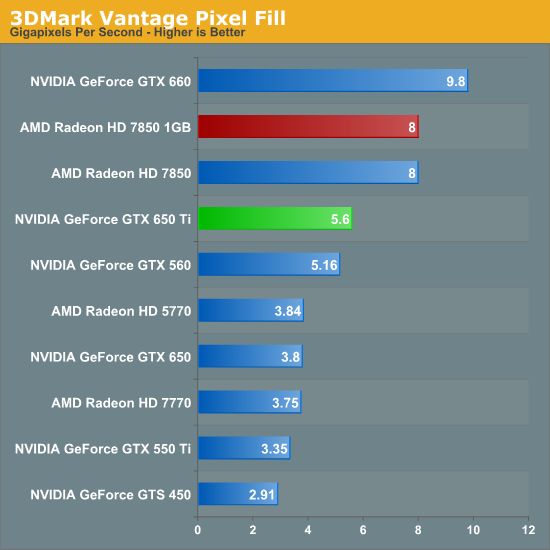
As expected, the GTX 650 Ti drops off a cliff compared to the GTX 660. Despite this, it does rather well compared to the GTX 650 despite the similar ROP throughput and memory bandwidth of the two cards. It can even edge out the GTX 560 in the process.
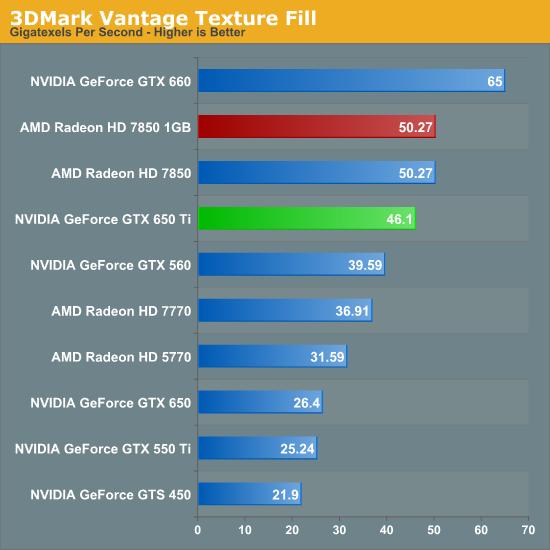
Meanwhile 3DMark Vantage’s Texture Fill test backs up our earlier texture performance expectations. The drop compared to the GTX 660 is still large, but not by nearly as much as the pixel fillrate. Having twice as many SMXes as the GTX 650 also means that it comes close to doubling the GK107 card’s performance here.
Our third theoretical test is the set of settings we use with Microsoft’s Detail Tessellation sample program out of the DX11 SDK
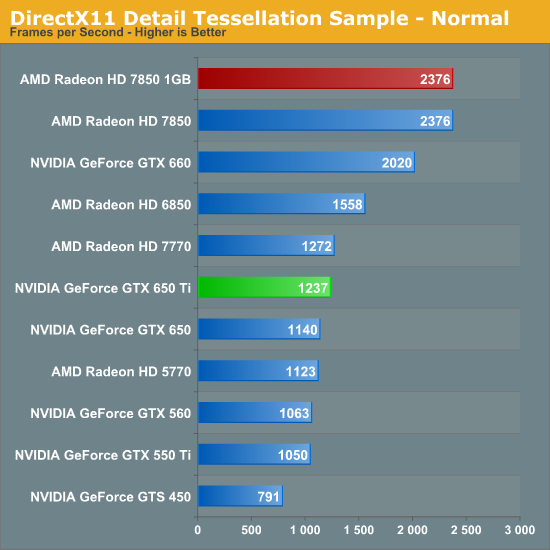
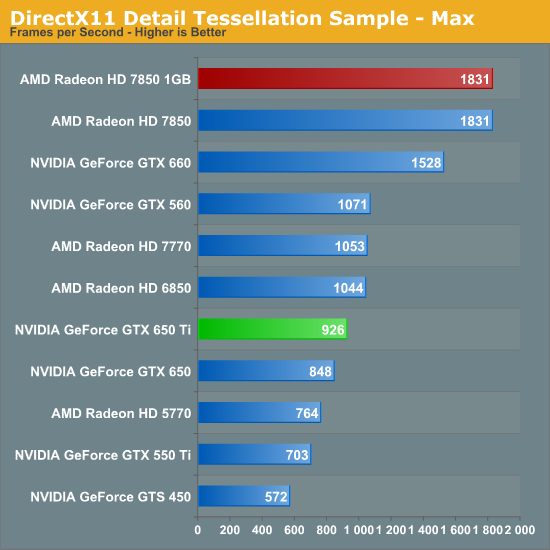
So much for tessellation performance holding up. This is admittedly a high pixel throughput test (we’re measuring at 1000fps+), but it’s also a very simple test that doesn’t have a great deal of overdraw. Despite the fact that the GTX 650 Ti holds on to most of GK106’s Polymorph Engines, performance drops by 40% relative to the GTX 660, which is far more in-line with the loss of ROP throughput and memory bandwidth.
Our final theoretical test is Unigine Heaven 2.5, a benchmark that straddles the line between a synthetic benchmark and a real-world benchmark as the engine is licensed but no notable DX11 games have been produced using it yet.
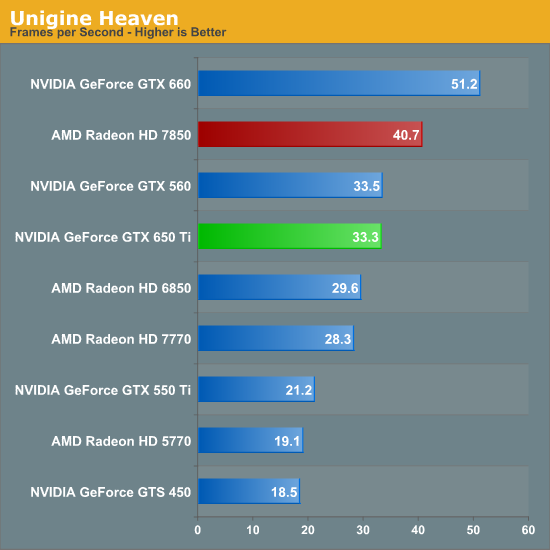
Despite everything else we’ve seen, Unigine results are almost exactly in the middle of the expected performance loss between shading/texturing and ROP/memory on the GTX 650 Ti. This makes it just good enough to tie the GTX 560, or surpass the GTX 550 Ti by nearly 50%.
Power, Temperature, & Noise
As always, we’re wrapping up our look at a video card’s stock performance with a look at power, temperature, and noise. Unlike GTX 660, GTX 650 Ti does not have GPU boost, which means the GTX 650 Ti’s load voltage is fixed at a single value. This is more important for overclocking, but because NVIDIA is not trying to min-max performance by sacrificing some power consumption, it allows the GTX 650 Ti to really turn down its power consumption. As a reminder, NVIDIA’s TDP here is 110W, with no power target (though NVIDIA throws around a “typical” number of 80W).
| GeForce GTX 650 Ti Series Voltages | |||||
| Ref GTX 650 Ti Load | EVGA GTX 650 Ti Load | Zotac GTX 650 Ti Load | Gigabyte GTX 650 Ti Load | ||
| 1.087v | 1.05v | 1.087v | 1.087v | ||
Without GPU boost voltages are quite low for desktop GeForce 600 cards. Instead of spiking at 1.175v we’re seeing a range from 1.05v to 1.087v. Meanwhile the idle voltage is typical for a GK106 card at 0.875v.
While we’re on the subject of voltages, it’s worth noting that while NVIDIA doesn’t have GPU boost active, this doesn’t mean they’ve thrown away Kepler’s power management system. Specifically there’s still a hard 1.175v ceiling, and at high voltages NVIDIA will still step down the voltage based on temperature in order to combat leakage. When overvolting our reference GTX 650 Ti we saw voltage step downs at a relatively low 56C, and another at 74C. This only applies to overvolting though, and there’s no corresponding reduction in clockspeed in any scenario.
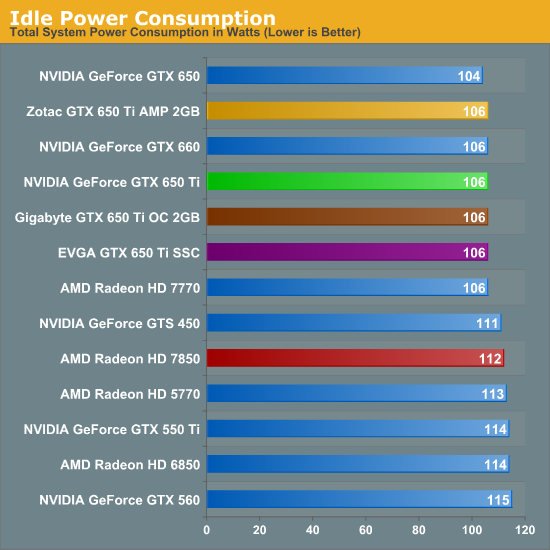
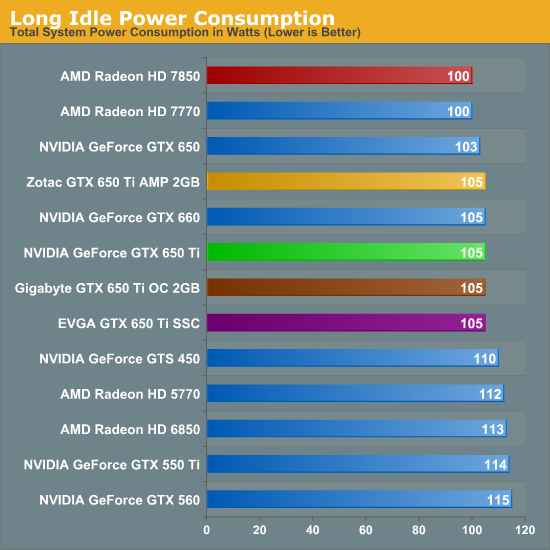
Starting as always with idle, having already seen the GK106 based GTX 660 there are no grand surprises here. Even with the disabling of some functional units the GTX 650 Ti doesn’t do any better than the full-fledged GTX 660, which is not to say that this is bad. At an NV estimated idle TDP of 5W this is still better than the 7800, and is good enough to tie the 7770. The factory overclocked cards fare no worse here either, all of which lead to our testbed hitting the same marks at the wall.
The one place NVIDIA can’t compete is in the long idle scenario with no active displays. The 7800 series still has a 5W advantage at the wall, though the benefits of something like AMD’s ZeroCore technology are not nearly as great here since the GTX 650 Ti can’t be SLI’d (and hence have a headless card).
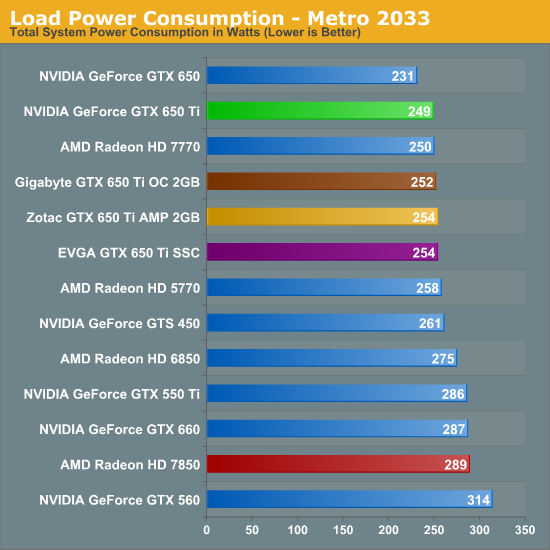
Moving on to load power consumption we’re finally seeing a test where the GTX 650 Ti has a clear architectural/design advantage over the competition. Though not strictly comparable, the 7850 has an official TDP of 150W versus 110W for the GTX 650 Ti, a difference of 40W. Meanwhile under Metro the gap between the 7850 and the GTX 650 Ti is exactly 40W (before taking into consideration PSU efficiency of course). Paper specs aside the GTX 650 Ti is clearly intended to be a lower power card than the 7850 and here it delivers. If it can’t beat the 7850 in performance then it is going to need to beat the 7850 on power consumption.
Meanwhile our factory overclocked cards present an interesting lineup. All 3 are closely clustered together in spite of the fact that the Zotac and Gigabyte cards have an extra 1GB of GDDR5 RAM to power. GDDR5 has quite the reputation for being a power hog (for a RAM), so it’s a bit surprising not to see a greater difference. The biggest driver of any power increase seems to be the overclocks themselves, leading to the marginally lower value we see for the Gigabyte card.
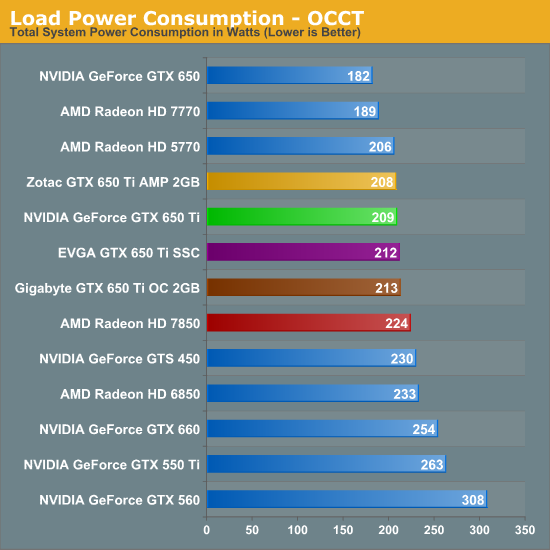
Turning to OCCT, the GTX 650 Ti doesn’t maintain the same large lead over the 7850 that it did with Metro thanks to AMD’s more aggressive throttling (and without GPU boost NVIDIA may as well not have any throttling), but reinforcing the fact that these cards are in two different power classes the GTX 650 Ti still ends up drawing less power. In fact it draws less power than the GTX 550 Ti or the GTS 450, the latter of which is not typically a high power card. Even without GPU boost – or perhaps especially without GPU boost – NVIDIA’s high power efficiency is maintained, though at a cost of rendering performance notably weaker than the immediate competition.
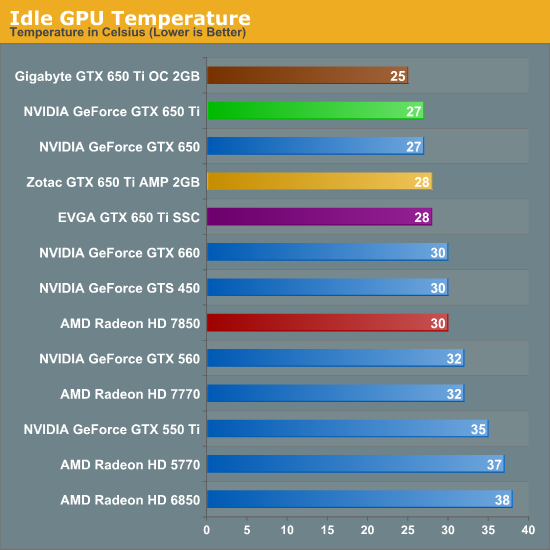
A low power GPU combined with open air coolers often leads to very low idle temperatures, and the GTX 650 Ti lives up to that tradition. It’s simply not that often that we see GPUs hit temperatures only a couple of degrees above room temperature. And in the case of Gigabyte’s card with its oversized that’s the lowest idle GPU temperature we’ve ever recorded, once more proving that there’s no kill like overkill.
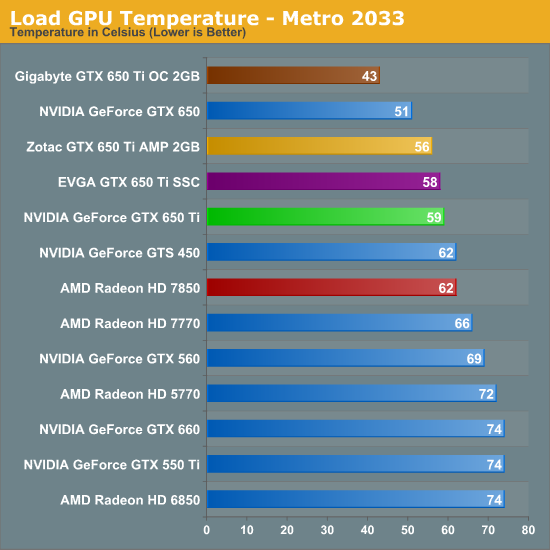
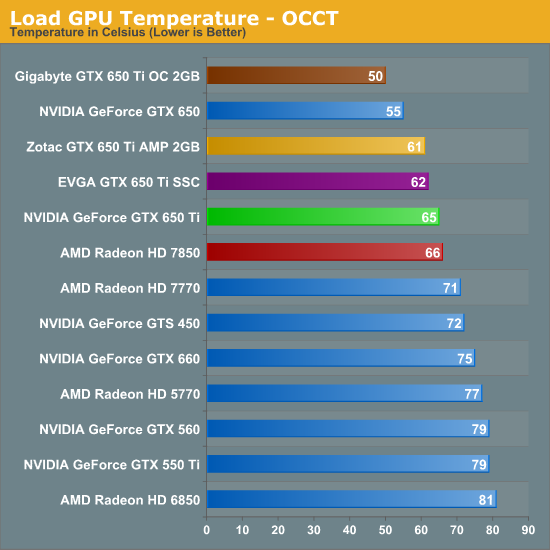
Moving on to load temperatures we get to see the effectiveness of an open air cooler combined with the relatively low power consumption of the GTX 650 Ti. At 59C under Metro and 65C under OCCT our reference GTX 650 Ti holds up amazingly well, and just wait until we get to the noise readings, since this is where the GTX 650 Ti and 7850 will really stand apart. Meanwhile even with their similar designs the EVGA and Zotac cards both end up being a bit cooler, than the reference GTX 650 Ti. But the real winner is the Gigabyte card and its oversized cooler; 43C with Metro is unheard of, and 50C with OCCT is as equally impressive.
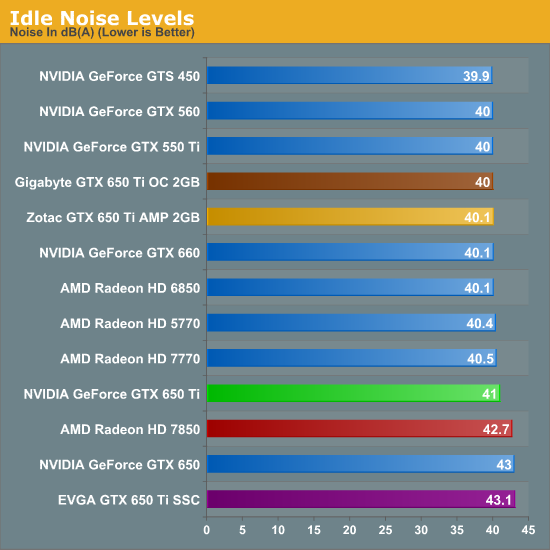
Transitioning to noise measurements we start with idle noise, where there is no great surprise as most cards have long since ceased having loud idle states. The EVGA card is a bit disappointing though, since there’s no great reason why such an open air card should be much above 41db(A).
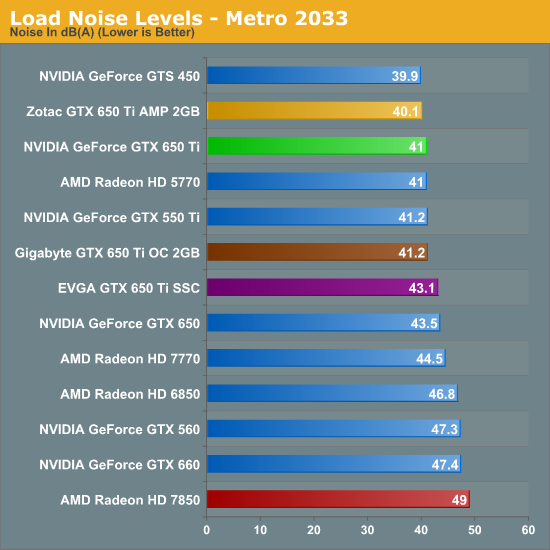
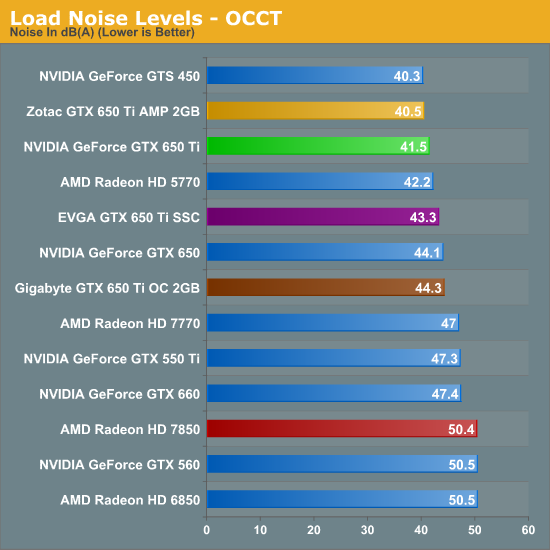
Taking a look at load noise we finally get to see the full picture. Earlier we had high praises for NVIDIA’s reference design, and this is the reason why. NVIDIA almost always hits a good balance between power, temperature, and noise, and nowhere is this more evident than with the GTX 650 Ti. Peaking at 41.5db(A) with OCCT it barely gets off of the noise floor. Meanwhile AMD’s reference 7850, complete with its blower, is almost 9dB(A) louder. Open air non-reference 7850s won’t be nearly as loud, but this is a reminder of what open air coolers can do, particularly when power consumption is low enough.
The real winner for load noise generation however is not NVIDIA’s reference design or even the Gigabyte card and its oversized cooler; it’s Zotac and their fairly plain open air cooler. Admittedly we’re looking at just a 1dB(A) difference, but if noise is crucial the Zotac card looks particularly good. Meanwhile the EVGA card, though starting out rough, doesn’t end up doing too poorly at load here. 0.3dB(A) is a tiny increase in noise over idle and it’s actually good enough to be in the middle of the pack for our retail cards.
The surprising result is the Gigabyte card, which should have the easiest time cooling. It looks like Gigabyte’s fan curve is a bit more aggressive than the rest of the GTX 650 Ti cards, which helps explain its amazingly low load temperatures, but that means there’s a noise tradeoff. Given the temperatures we’re seeing, Gigabyte was a little too aggressive with their fan curve; had they not then they could have easily swept this entire section.
Overclocking: Power, Temperature, & Noise
Our final task is our look at the overclocking capabilities of our GTX 650 Ti cards.
Because the GTX 650 Ti is based on a lower clocked GK106 we should have more headroom to play with. Furthermore because GPU Boost is not present, and hence NVIDIA is not min-maxing GPU clockspeeds in the first place, there should be even more headroom to play with. For overclockers dissatisfied with overclocking in the world of GPU Boost, the GTX 650 Ti is going to be a return to old fashioned overclocking.
As an added benefit, because GPU Boost is not present NVIDIA is not operating these cards so close to their 1.175v limit. While it’s true the 1.175v limit is still in place, with the average shipping voltage being nearly 0.1v below that limit there’s some overvolting headroom to play with that GeForce 600 cards don’t typically get to experience.
| GeForce GTX 650 Ti Overclocking | ||||||
| Ref GTX 650 Ti | EVGA GTX 650 Ti SSC | Zotac GTX 650 Ti AMP | Gigabyte GTX 650 Ti OC | |||
| Shipping Core Clock | 925MHz | 1071Mhz | 1033MHz | 1033MHz | ||
| Shipping Memory Clock | 5.4GHz | 5.4GHz | 6.2GHz | 5.4GHz | ||
| Shipping Load Voltage | 1.087v | 1.05v | 1.087v | 1.087v | ||
| Overclock Core Clock | 1175MHz | 1175MHz | 1175MHz | 1175MHz | ||
| Overclock Memory Clock | 6.6GHz | 6.6GHz | 6.6GHz | 6.6GHz | ||
| Overclock Load Voltage | 1.162v | 1.15v | 1.162v | 1.162v | ||
When we’re looking at cards similar to a reference design it’s not unusual for those cards to top out at similar clockspeeds. It’s not even rare to have two cards top out at the same spot. But it’s highly unusual to have all 4 cards top out at the same point: 1175MHz core and 6.6GHz memory. Despite our best efforts each and every card would fail 1200/6.7 at some point, forcing us back down to the clockspeeds you see above. Perhaps what is most interesting is that none of the factory overclocked cards managed to push higher than our reference card, or even higher than one-another for that matter. Given what we’re seeing it looks like GK106 is naturally capable of 1050MHz+ clockspeeds, so the amount of failed chips coming out of factory overclock binning should be minimal.
Oddities aside, these overclocks are quite good. Compared to the reference GTX 650 these clocks represent a 250MHz (27%) core overclock coupled with a 1.2GHz (22%) memory overclock. These are far greater overclocks than what we’ve seen on any other GeForce 600 series card to date, once again thanks to the fact that the GTX 650 Ti’s clockspeeds are so low due in large part to a lack of GPU Boost. Budget overclockers will almost certainly be quite pleased with the GTX 650 Ti, though it’s worth noting that its closest competition is the similarly overclocking-friendly 7850.
Moving on to our performance charts, we’re going to once again start with power, temperature, and noise, before moving on to gaming performance.
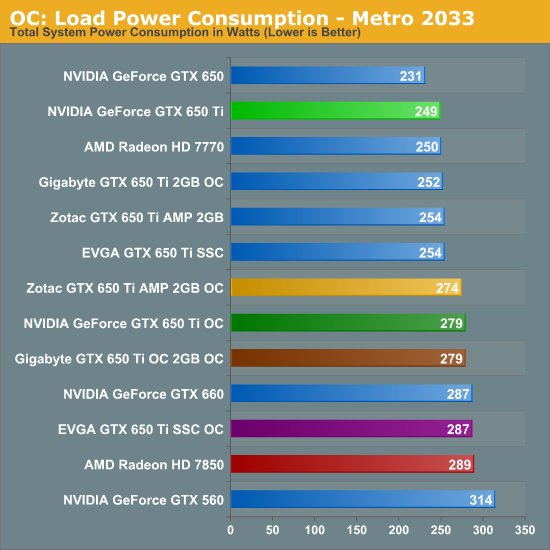
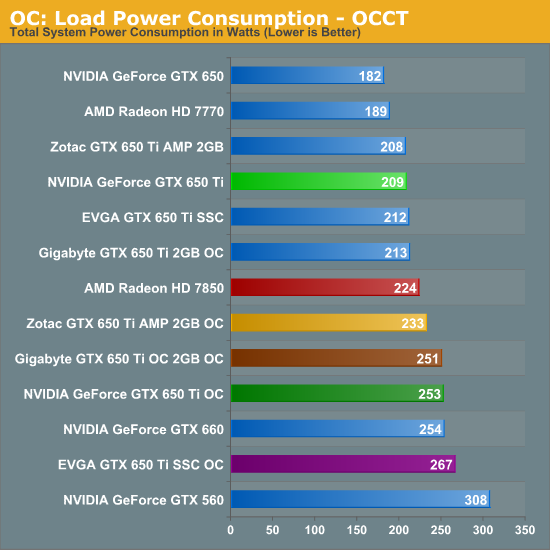
Unlike overclocking cards with GPU Boost, in the case of the GTX 650 Ti we are unquestionably overvolting the card. As a result the power consumption penalty for overclocking is quite harsh on a relative basis, though thankfully the GTX 650 Ti starts out low enough that the PCBs and the coolers are having no problem keeping up.
Overall, our overclocking efforts have pushed the power consumption of our GTX 650 Ti cards up by 30-40W, which puts power consumption just below the GTX 660 and 7850. The best performing card in this regard – that is, the card with the smallest increase in power consumption – is the Zotac card, followed by the close pairing of the Gigabyte card and the reference card, and finally EVGA’s card. This is one of those cases where a sample size of 1 just isn’t big enough, so there’s no clear reason why Zotac does so well or EVGA fares so poorly. Looking at temperatures it may be that we’re seeing temperature induced leakage, then again it may be that the hottest card is the hottest because of that power consumption.
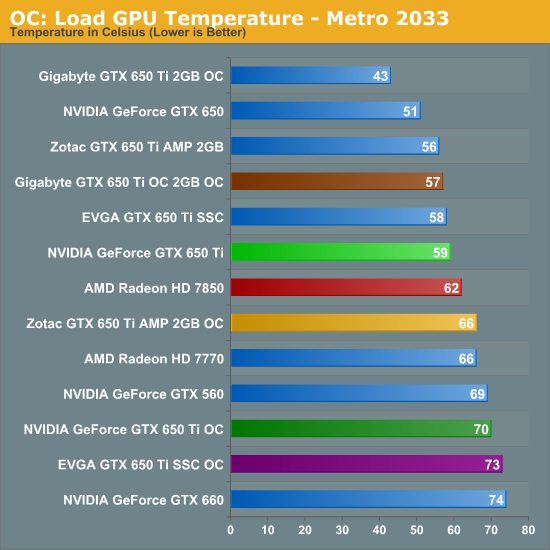
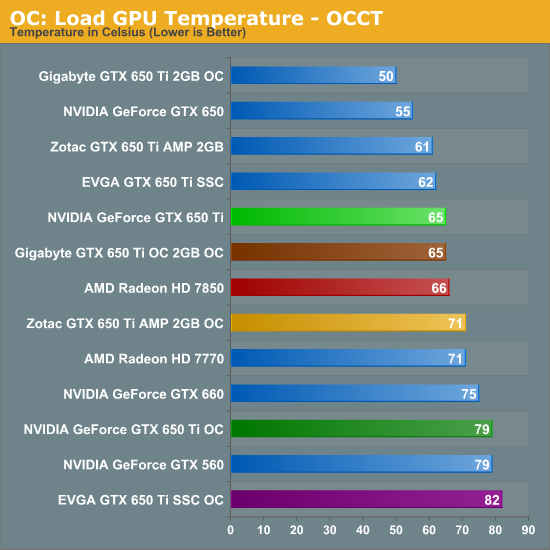
Next up is load temperatures. As we’ve already seen in our look at stock performance the Gigabyte card has a relatively aggressive fan curve, which is great for temperatures at the cost of noise. As a result even in the worst case scenario of OCCT it only hits 65C, 6C cooler than the next-closest overclocked card. That brings us to the Zotac card, which isn’t as cool as Gigabyte’s card but at 71C is still doing rather well. This is followed by the reference card at 79C, and finally the EVGA card at 82C.
Given the amount of power we’re channeling through these cards, it’s rather surprising just how well they hold up here. Even with these small coolers GPU temperatures are well into the safe zone, though the EVGA card is about as hot as we’d let such a card get under normal circumstances.
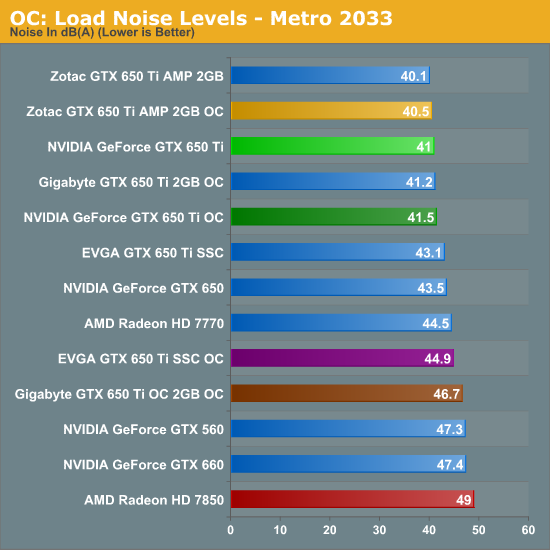
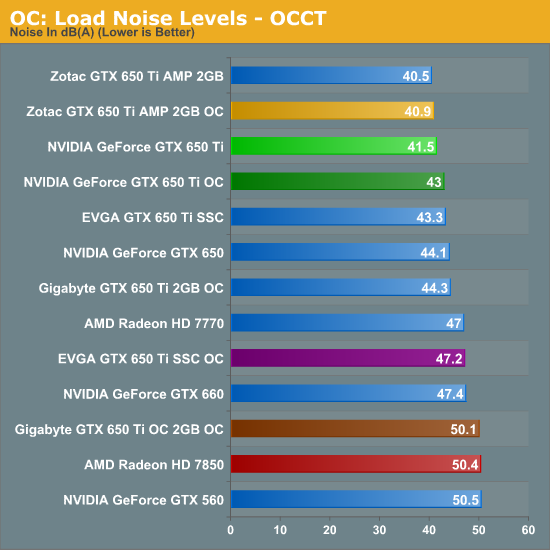
Moving on to noise, the cards that were previously doing well with stock settings continue to do well, while the rest of the cards fall further behind the leaders. The quietest card remains the Zotac, which even overvolted and running OCCT still doesn’t pass 41dB(A), which is simply incredible given the amount of power it’s pulling by this point. And as we’ve already seen its temperatures are respectable too, so Zotac seems to have hit the perfect balance here.
At the other end of the spectrum we have the EVGA and Gigabyte cards. Gigabyte continues to fall behind due to their aggressive fan curve, while the EVGA card and its poor overclocked temperatures require the card to push the fan even harder to keep up. Neither one of these cards is doing an acceptable job in light of what the Zotac card nor the reference card are achieving.
Overclocking: Gaming Performance
Because all of our GTX 650 Ti cards hit the same clockspeeds when overclocking, there’s absolutely nothing to meaningfully separate them from one-another when it comes to gaming performance. The real difference was in their power consumption, temperatures, and fan noise.
With that in mind, the performance improvement is nothing short of astonishing. Between the 27% core overclock and the 22% memory overclock we’re looking at performance gains in the range of 20-25%. This isn’t enough to catch the GTX 660, but it’s enough to improve performance in a number of situations, including making 1920x1200 playable more often. It goes without saying that this is also enough to catch up to the stock 7850 in those scenarios where the 7850 isn’t leading by more than 25%.
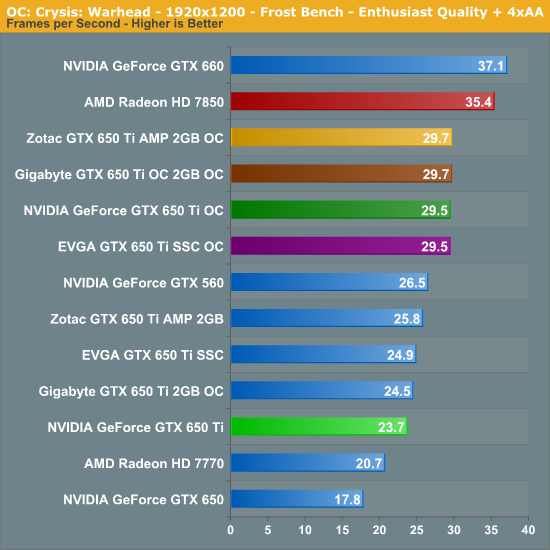
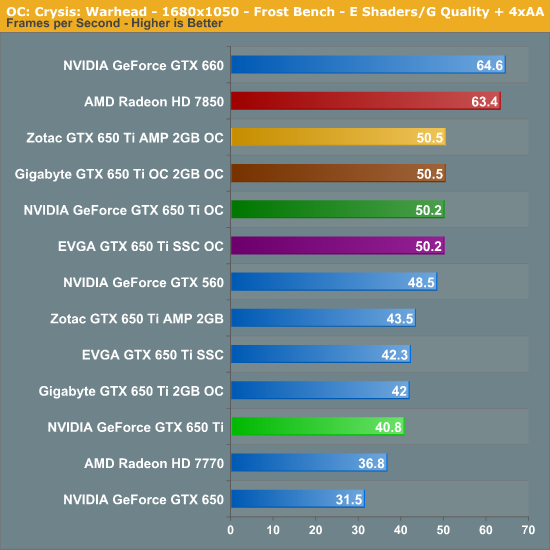
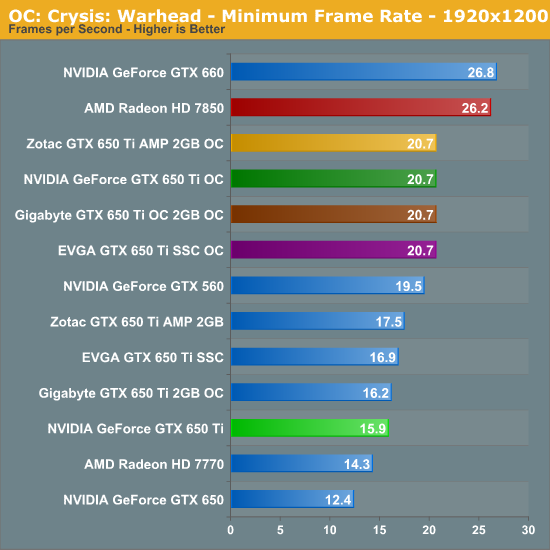
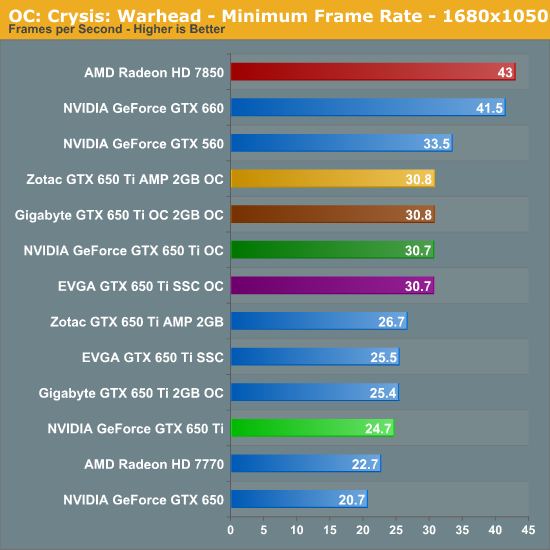
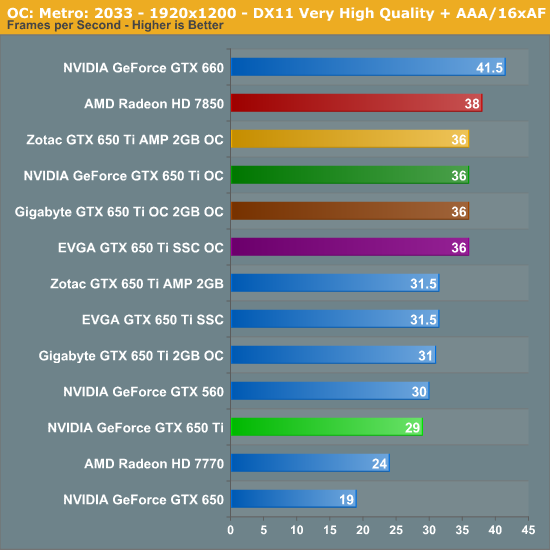
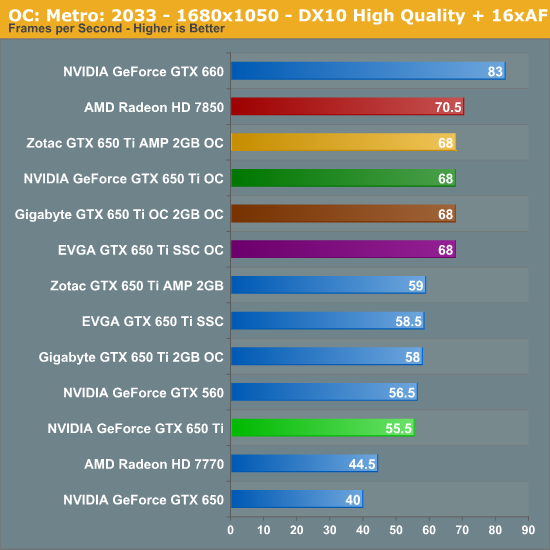
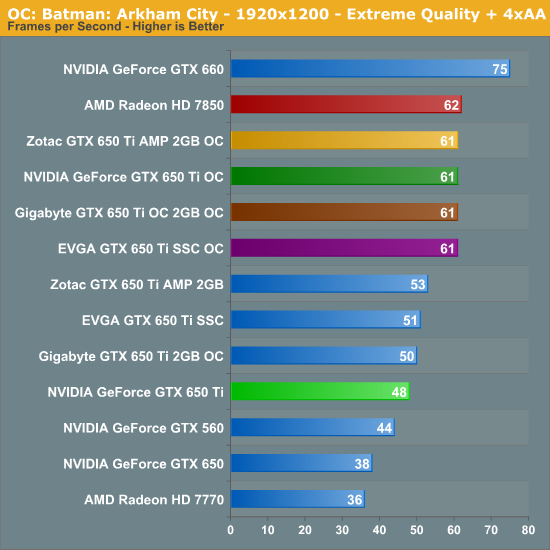
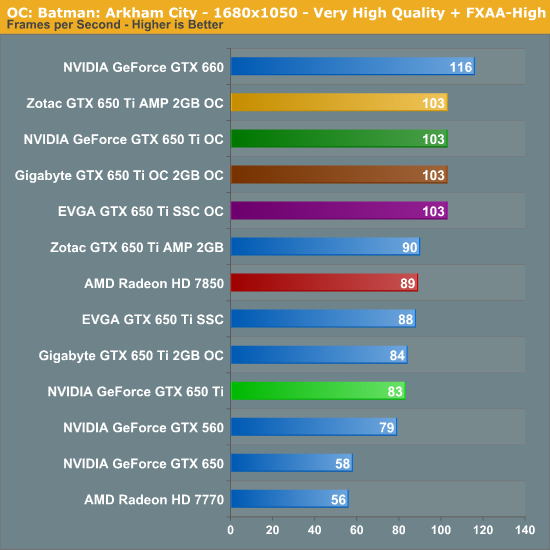
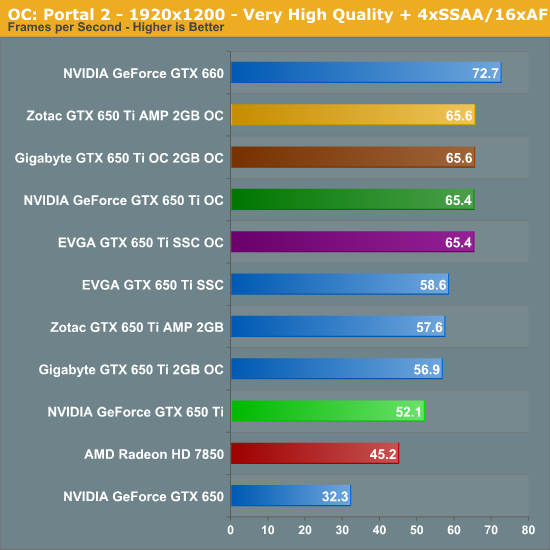
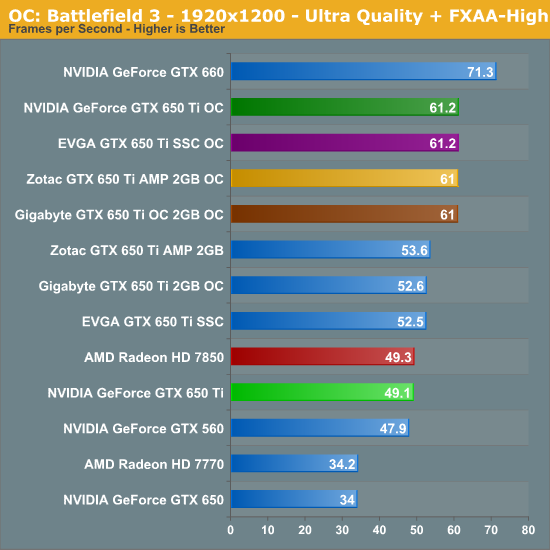
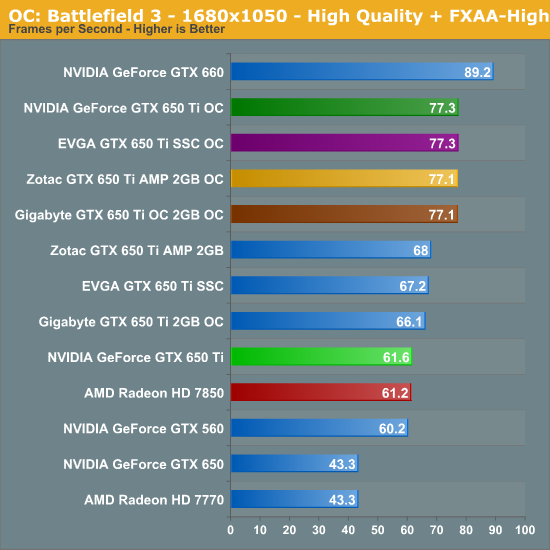
Final Words
With every launch of a GeForce 600 series card NVIDIA has had a specific market target in mind. Typically those targets intersect or undercut an AMD market, and while AMD has not been caught off-guard with subsequent launches like they were the launch of the GTX 680, NVIDIA has so far managed to stay on equal or better footing as AMD. Or at least that was the case until today with the launch of the GeForce GTX 650 Ti.
To be clear, the GeForce GTX 650 Ti as it’s configured does not have a direct competitor, and this is something NVIDIA specifically planned for. At $149 it’s squeezed in between the Radeon HD 7770 and the Radeon HD 7850, which happens to be a rather wide performance gap. Under normal circumstances this would be a very good plan, as it means NVIDIA can tap a market segment that AMD wasn’t adequately serving before, while at the same time direct avoiding competition with AMD. But such a plan relies on AMD not making an aggressive move in return.
To that end if AMD had done nothing we would be talking about how the GTX 650 Ti is an excellent fit for the market at $150, and a solid step up from its predecessor the GTX 550 Ti. Instead AMD and their partners executed on the Radeon HD 7850 not a price cut, chopping $20 off of the price of a Radeon HD 7850 and bringing out further 1GB models to bolster their closest GTX 650 Ti competitor. So often we talk about the significance of $20 in the sub-$200 market, and this is another one of those cases.
The fact of the matter is that from a price/performance perspective the $149 GTX 650 Ti 1GB is not competitive enough with the $169 Radeon HD 7850 1GB. At its best the GTX 650 Ti can match the 7850, and at its worse it can only keep up with a 7770. The end result is that most of the time the GTX 650 Ti is going to lose to the 7850 by more than the 13% price difference between the two, which means that NVIDIA is coming up short even if they are the cheaper option.
Instead we fall back to that old maxim, “there’s no such thing as a bad product, only a bad price”. For the GTX 650 Ti to be a competitive success it needs to come down in price in response to the lower price of the 7850. The fact that NVIDIA added an Assassin’s Creed III bundle is likely an attempt to subvert a proper price cut, and while we’re big fans of game bundles it’s not the same as a price cut. If NVIDIA could cut even $10 off of the price of the GTX 650 Ti they could escape the 7850’s shadow and at the same time return the favor to AMD by putting pressure on the 7770. As it stands today the GTX 650 Ti only makes real sense for buyers who absolutely cannot go over $149, and they’re going to have to give up a lot of performance as a result.
Ultimately, to NVIDIA’s credit the GTX 650 Ti is a perfectly competent card at 1680x1050, which is right where you’d expect a 650 series part to be. The performance is right for that segment and the power consumption taken in light of the 7850 is very impressive. But AMD rules from the price/performance perspective, and in the meantime that power advantage just isn’t enough when both cards are sub-150W cards. As we’ve seen time and time again, and as the last thing we’ll see in 2012, when it comes to mainstream cards $20 makes all the difference in the world. For NVIDIA it’s the sole reason that Ti is not Au.
Finally, let’s talk about our factory overclocked retail cards for a bit. With the exception of the Gigabyte Windforce card, most of these retail cards are going to go with designs similar to the NVIDIA reference design, and accordingly they’re going to perform similarly. This is not a bad thing as the NVIDIA reference design is quite good, but it does make life a bit harder for NVIDIA’s partners as they have to compete on non-benchmark attributes like software and warranties as opposed to raw performance.
The biggest problem the partners will face is that while their factory overclocked cards are a good 10%+ faster than reference clocked cards, they’re running headlong into that $169/$189 wall imposed by the 7850. The added performance gets neutralized by the added cost, keeping them on the same price/performance curve as the reference clocked GTX 650 Ti. The end result is that while the factory overclocked cards we’ve looked at today are worth the premium, buyers are still better off with (and are now closer to) the 7850.
Ignoring for a moment the fact that not every partner will make their factory overclocked SKUs available in both a 1GB version and a 2GB version, of all the cards we’ve looked at there is a clear winner in Zotac’s GeForce GTX 650 Ti AMP! 2GB card. It has the best balance of power consumption, temperature, and noise under both stock and overclocked conditions, plus it has one of the best overclocks; all of which is enough to justify the $10 price premium over a standard 2GB card. Gigabyte’s card also looks interesting due to the sheer size of the Windforce cooler, though in our experience a manual fan curve might be necessary to find the best balance between noise and temperature, as the card shouldn’t need to get that loud to keep up with the relatively low power consumption of the GTX 650 Ti GPU.
Of course all of these projections are made with respect to stock performance. If our results are anywhere close to what other retail cards do – and we believe they are – then overclocking is going to be extremely similar across all cards, regardless of a factory overclock or not. For buyers who do intend to overclock it’s a safe bet to say that they’d best be served by an at-MSRP reference clocked card, where they can achieve the same impressive results while pocketing the extra $10. And since most partners are using the same coolers for both their reference clocked and factory overclocked cards this makes choosing such a card a fairly easy process.

